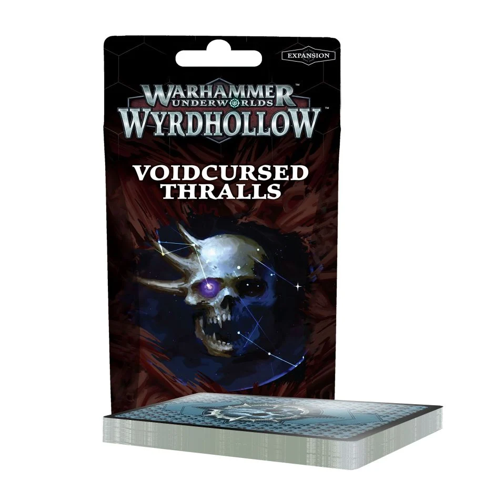
Intro
Next up we have the Voidcursed Thralls Rivals deck, which I have to say is one of the more unique themes they’ve gone for with a deck. The idea of spreading this curse to both friendly and enemy fighters in an effort to score objectives or unlock power card effects makes for an interesting minigame that we’ve not really seen out of the Rivals decks to date, with the closest being the exploration mechanic from Daring Delvers. While the concept I think is very solid, we’ll have to see how its execution develops as people play the deck. As you’ll see throughout my commentary, I do worry a bit for the use of this deck in constructed formats, as I believe it leans even more heavily on its internal synergies than the other universal decks. Flavor-wise though, this deck absolutely gets an A+. The art and the whole Tynis von Artzen saga in the flavor text of the cards is just perfectly on theme and excellent. That’s enough for a teaser, let’s get into the deck itself!
Plot Card

The groans from Championship players about plot decks has been lessened of late by the release of 3 consecutive non-plot decks, so I suppose we were about due for one. At least the shackles of the plot lock no longer feel quite so restrictive as they did prior to the release of Beastbound Assault, so you can still, even with the lock in place, exhibit some creativity in your deck building (in fact, I’ve been having a blast building Championship decks lately, it’s way more interesting than in Gnarlwood). I know there is some misconception that us Championship folks “hate” plot cards, but this is not actually the case. We may grumble about the fact that we can’t mix and match cards from multiple plot decks, but as long as the plots themselves are implemented in a meaningful and interesting way, I think they’re pretty cool.
Little bit of a tangent to start off there, so let’s get back on track discussing the actual plot card for this deck, which is constructed around the Voidcursed keyword (that will be the only time I bold and capitalize that word, I’m going to be saying it far too often to be bothered…). At the beginning of each round, if there are no surviving friendly voidcursed fighters, you choose one to become voidcursed. That fighter cannot make actions besides Move, Attack, and Charge, cannot be driven back, cannot make Range 3+ attack actions, and has a Defence characteristic of 1 Shield (note that you can still apply modifiers). A lot to unpack there, but, right off the bat, the most obvious thing to talk about is that there are a lot of warbands who have fighters they really don’t want voidcursed. While not every Rivals deck has to work for everyone, the combination of the defensive restriction and elimination of Range 3+ attacks cuts out a wide swath of warbands from wanting to use it. Sure, you don’t have to curse your whole warband, but it would be nice to not have fighters you are concerned about the curse spreading to. Similarly, being unable to perform on-card actions can be really debilitating for certain fighters like Deintalos. For this reason, the most notable synergy here would be Range 1 fighters who already defend on 1 Shield or 1 Dodge anyway. Aggro warbands like Garrek’s Reavers and Ironskull’s Boyz come to mind almost immediately as warbands who tend not to care about the downsides of the keyword and will just go and smash face anyway. Mollog also appreciates the idea of not being driven back. While the recent WarCom announcement also proclaimed it as an aggro-focused deck, that actually is not the only synergy you can pull here. For example, Chosen Axes could take this, since they all defend on 1 Shield anyway, to increase their odds of pulling off that key Round 1 inspiration on a particular fighter thanks to the “cannot be driven back.” You could even apply this logic to a number of other bulky HO fighters like Slakeslash or fighters on Sepulchral Guard. While the deck does have some focus on moving into enemy territory and spreading the curse, the innate effect of the keyword (and some of the cards we will get into shortly) definitely dip into control or HO playstyles, so I would recommend not falling into the trap of looking at this as “just another aggro deck.”
Objectives
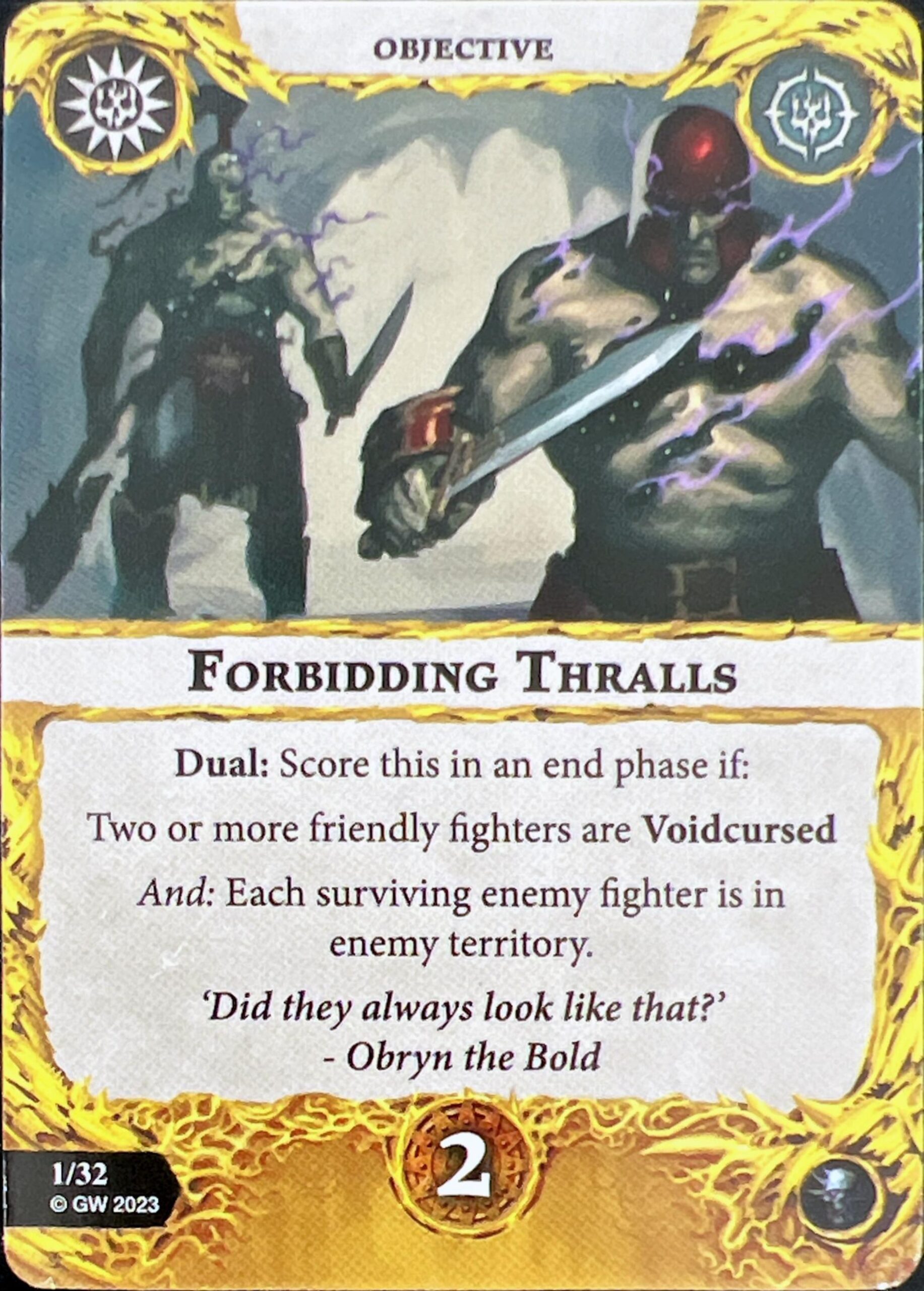
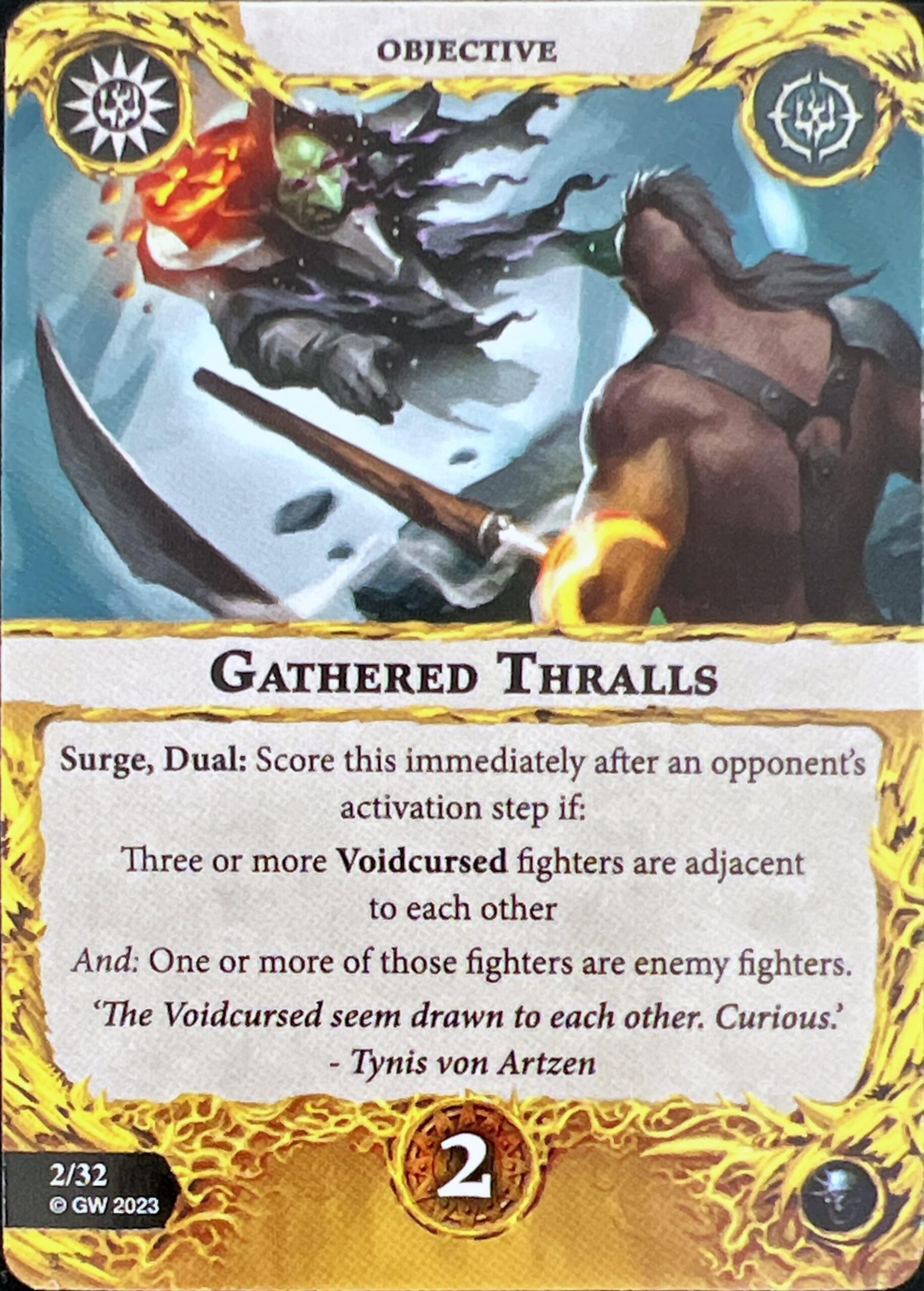
Forbidding Thralls is our first objective as a dual 2-glory end phase card for having 2 or more friendly voidcursed fighters and each surviving enemy fighter being in enemy territory. This is a bit of a meta call card on trying to punish more passive warbands, such as Stormcoven, who don’t necessarily need to move towards you up the board. While it can certainly do that quite well, aggro is still a very popular choice, especially in Nemesis, and they almost exclusively prefer to charge across the line and into your territory. Frankly, there are plenty of aggro warbands that you’re just not going to stop from coming in. If you’ve tried to play [![]() Path of Death]
Path of Death]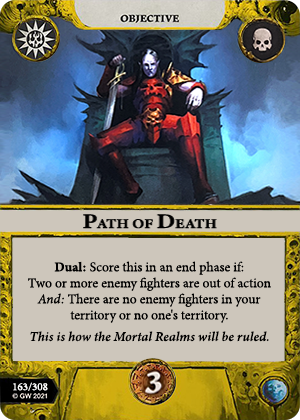 before, you’ll be familiar with the struggles against Soulraid, as well as Spiteclaw’s Swarm and Grymwatch, even though those two aren’t really aggro choices. Horde aggro, particularly with the genesis of “checkers”-type gameplay associated with warbands like Reapers or Exiled Dead built around scoring cards like [
before, you’ll be familiar with the struggles against Soulraid, as well as Spiteclaw’s Swarm and Grymwatch, even though those two aren’t really aggro choices. Horde aggro, particularly with the genesis of “checkers”-type gameplay associated with warbands like Reapers or Exiled Dead built around scoring cards like [![]() Taking Advantage]
Taking Advantage]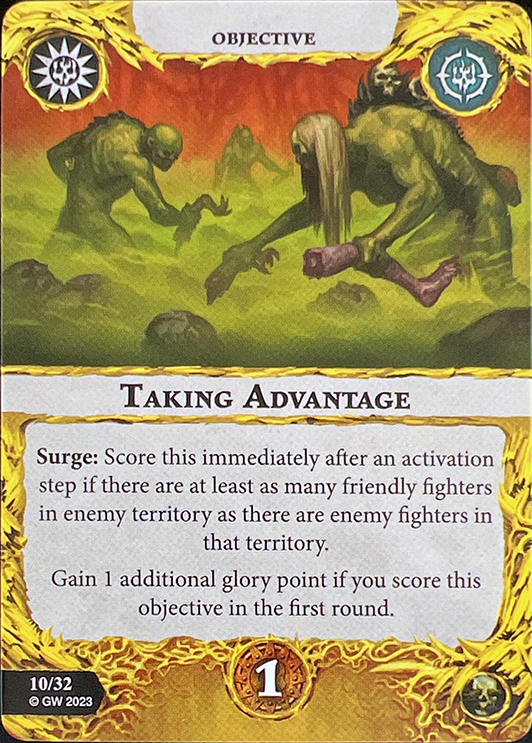 and [
and [![]() Lengthening Shadows]
Lengthening Shadows]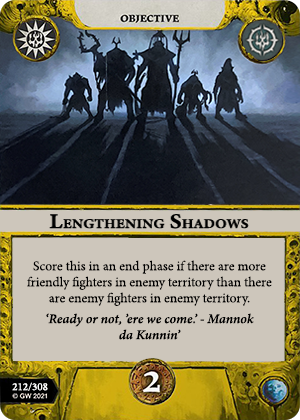 can also be difficult to fully keep out. As much as you’d love to be able to swindle some control warband out of 2 glory, I just don’t think it’s consistent enough to warrant general inclusion against the wider meta.
can also be difficult to fully keep out. As much as you’d love to be able to swindle some control warband out of 2 glory, I just don’t think it’s consistent enough to warrant general inclusion against the wider meta.
Power Ceiling: 2, Consistency: 1, Universality: 1
As is custom these days, we have big 2-glory surge for the Rivals deck, this one being Gathered Thralls, which scores immediately after an activation if 3 voidcursed fighters are adjacent to each other and one or more of those are enemy fighters. Definitely some echoes of [![]() Scrum]
Scrum] and [
and [![]() Impending Doom]
Impending Doom]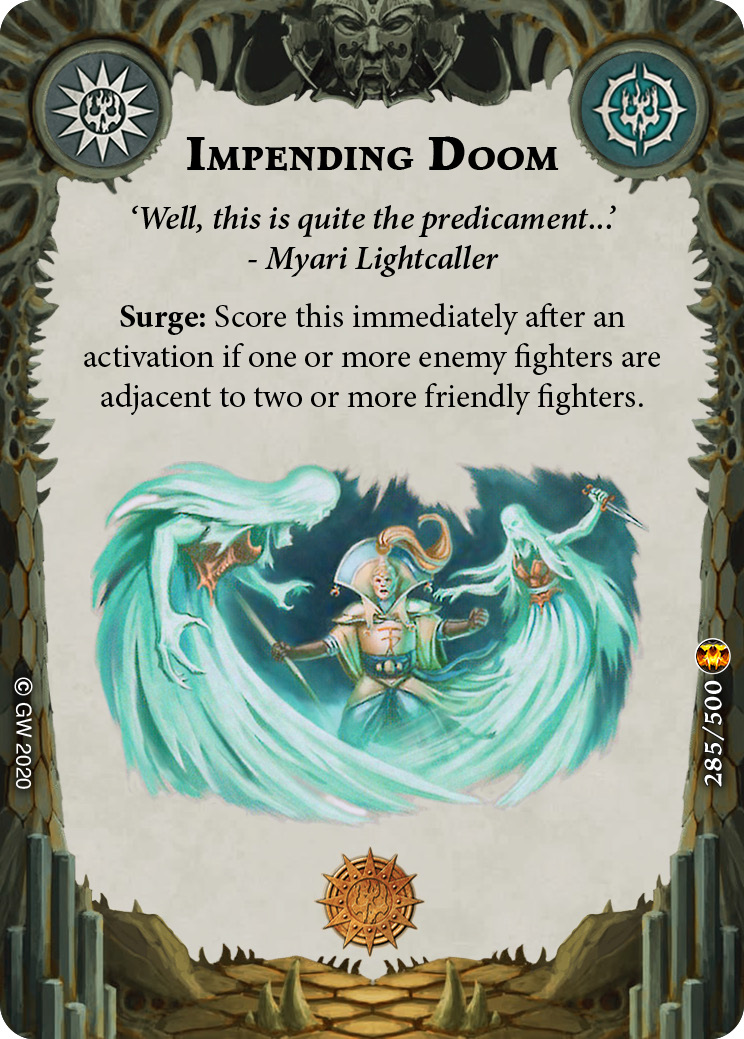 here, so you probably look towards warbands like Gitz or Reapers that profited quite a bit from those cards (Exiled Dead would make sense too). However, here we have the obvious difficulty that you need to really lean into the voidcursed mechanic to make sure you can satisfy that end of it. As is fairly common lately, this makes it quite a bit better in Rivals and Nemesis than in Championship. I do find this type of card design a bit odd, not in the sense that they want to push those formats, which is fine, but more so that I don’t fully understand why we need to impose the plot lock if cards like this will effectively be plot-locked anyway. In a world where we eliminate the plot lock, you still are only taking this card if you are also packing a lot of power card support for the voidcursed mechanic, which naturally preempts you from being able to fit pieces from other plot decks. I know this is a bit of a tangent, but I wanted to discuss it early because this general commentary does apply to a lot of the cards in this deck and it does make the cards difficult to rate as a whole, even if I were just rating for Nemesis. Some warbands have such strong Rivals decks that you would have to forgo a lot of powerful in-faction cards to pack in sufficient voidcursed tech. In this case (and several other objectives in this deck), you also gain a lot from playing a mirror match, but definitely the combination of needing to pack lots of tech yourself and the maybe/maybe not that your opponent is also using this deck makes the outcome fairly swingy.
here, so you probably look towards warbands like Gitz or Reapers that profited quite a bit from those cards (Exiled Dead would make sense too). However, here we have the obvious difficulty that you need to really lean into the voidcursed mechanic to make sure you can satisfy that end of it. As is fairly common lately, this makes it quite a bit better in Rivals and Nemesis than in Championship. I do find this type of card design a bit odd, not in the sense that they want to push those formats, which is fine, but more so that I don’t fully understand why we need to impose the plot lock if cards like this will effectively be plot-locked anyway. In a world where we eliminate the plot lock, you still are only taking this card if you are also packing a lot of power card support for the voidcursed mechanic, which naturally preempts you from being able to fit pieces from other plot decks. I know this is a bit of a tangent, but I wanted to discuss it early because this general commentary does apply to a lot of the cards in this deck and it does make the cards difficult to rate as a whole, even if I were just rating for Nemesis. Some warbands have such strong Rivals decks that you would have to forgo a lot of powerful in-faction cards to pack in sufficient voidcursed tech. In this case (and several other objectives in this deck), you also gain a lot from playing a mirror match, but definitely the combination of needing to pack lots of tech yourself and the maybe/maybe not that your opponent is also using this deck makes the outcome fairly swingy.
Power Ceiling: 3, Consistency: 1, Universality: 2
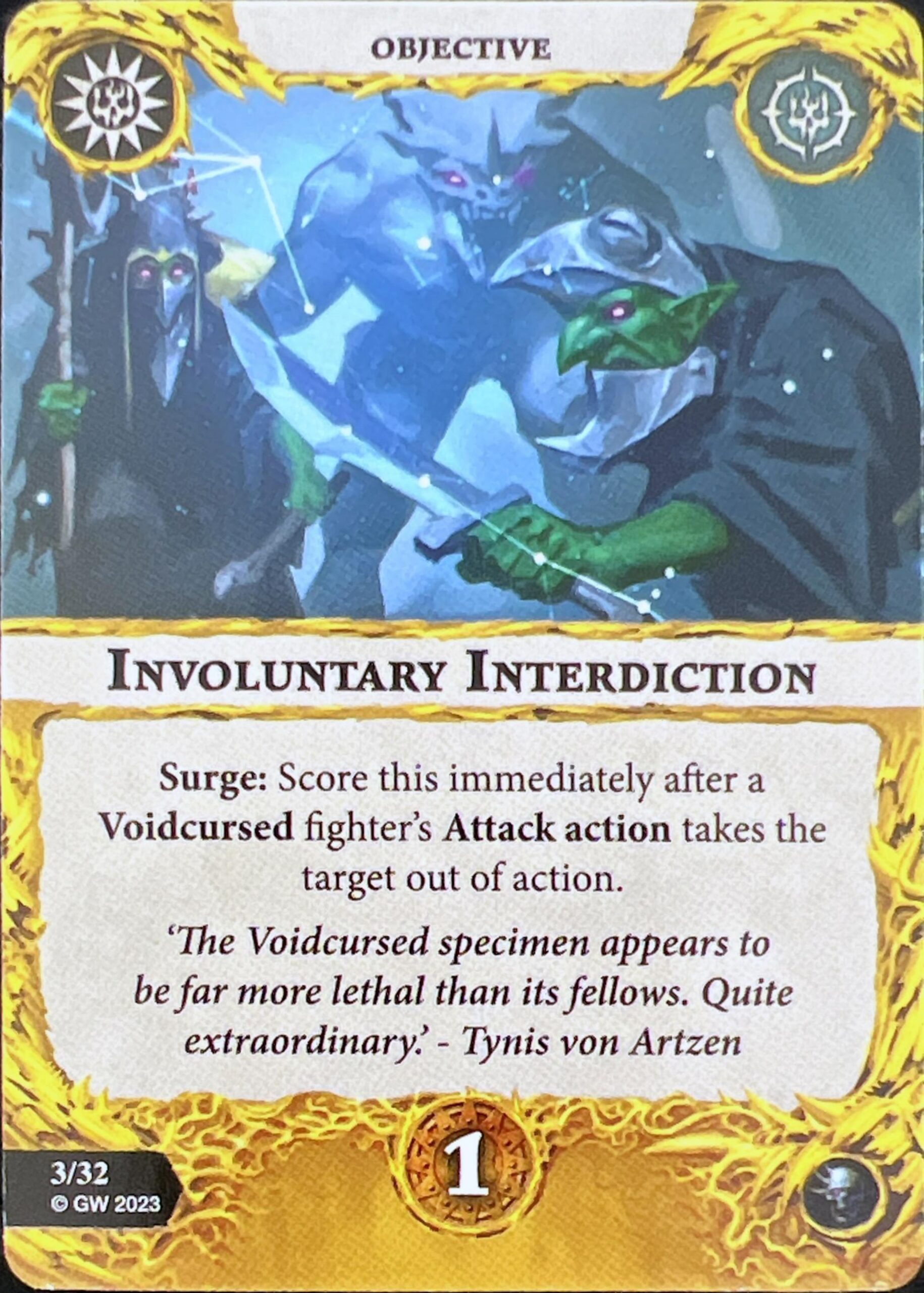
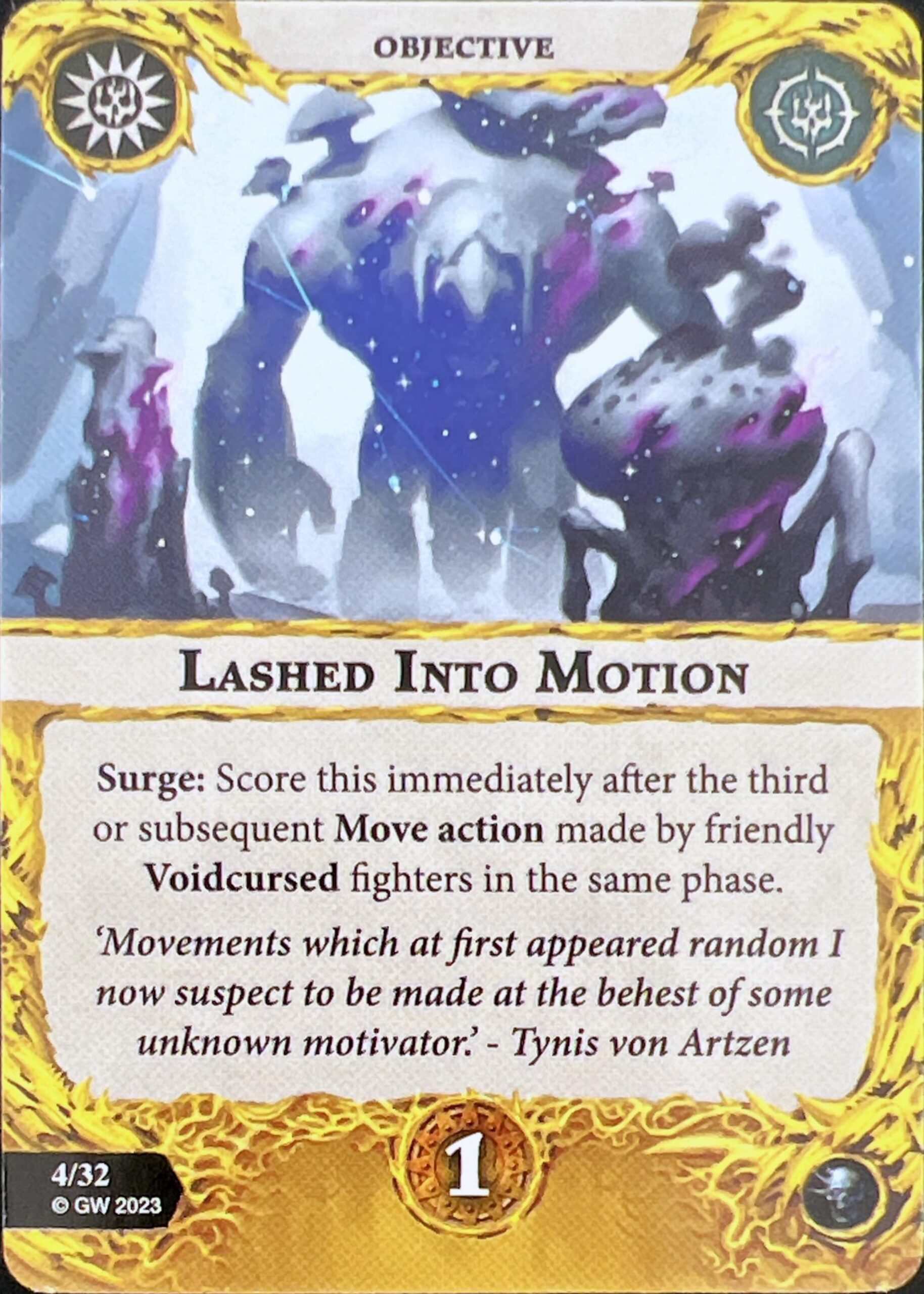
Involuntary Interdiction is the modern-day Rivals deck kill surge of “fighter who is [insert Rivals deck keyword] takes an enemy fighter out of action.” It’s certainly fine, especially since you get to choose which of your fighters get voidcursed, but, as always, I tend to shy away from kill surges unless they are basically automatic when you kill something (e.g., [![]() Savage Slaughter]
Savage Slaughter]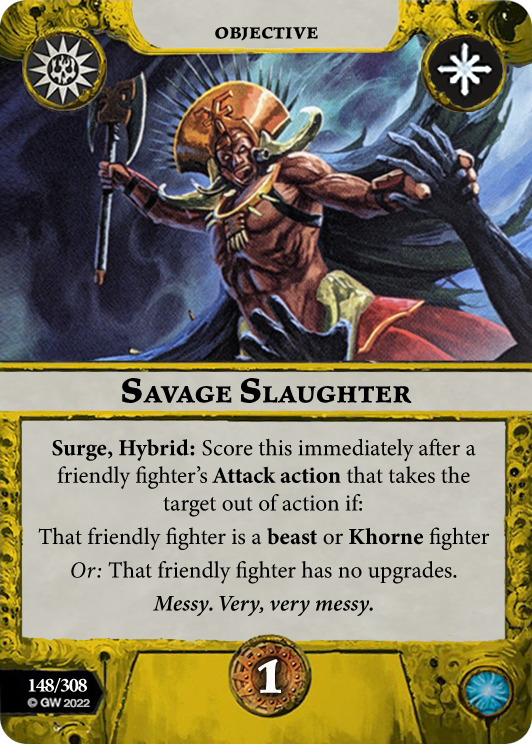 ) or have some glory upside (e.g., [
) or have some glory upside (e.g., [![]() Sudden Demise]
Sudden Demise]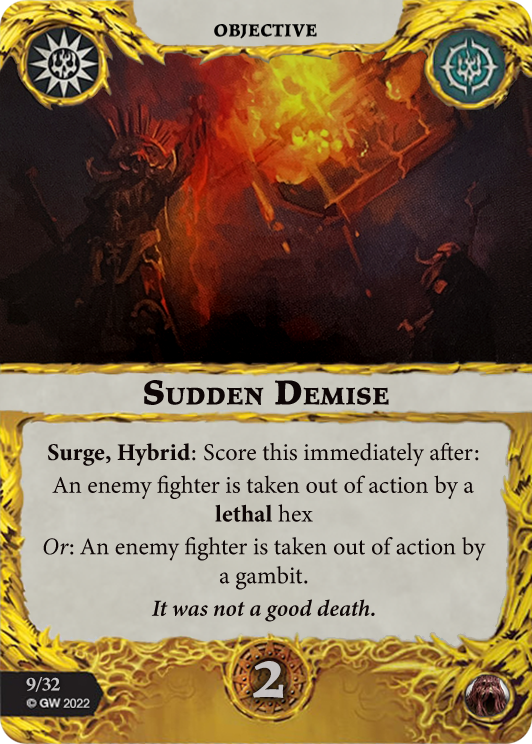 ). I could see Mollog liking this one I suppose, since he seems like the most suitable choice to voidcurse in that warband, but otherwise I would say there are a lot of cases where you might not be able to rely on that kind of offensive output from the voidcursed guy. Most warbands taking this deck in Nemesis might not have a choice but to take the card, and it will certainly be scoreable, but I would still try to find some more passive scoring in a constructed format, especially Championship.
). I could see Mollog liking this one I suppose, since he seems like the most suitable choice to voidcurse in that warband, but otherwise I would say there are a lot of cases where you might not be able to rely on that kind of offensive output from the voidcursed guy. Most warbands taking this deck in Nemesis might not have a choice but to take the card, and it will certainly be scoreable, but I would still try to find some more passive scoring in a constructed format, especially Championship.
Power Ceiling: 2, Consistency: 2, Universality: 2
Lashed into Motion is a 1-glory surge that scores for making your third or subsequent move action with friendly voidcursed fighters in the same phase. If you are able to spread the curse to a few of your fighters, the multi-move warbands could certainly make this quite trivial, especially given some of the power card support we will get into later in the deck. For example, you could voidcurse 3 zombies, then do one Danse Dynamic to score this pretty freely. The obvious hurdle here is actually spreading the curse sufficiently to score this, as you do only start with one fighter with the curse. You could potentially use one of the dogs on Hexbane’s Hunters to carry you early here, but I generally think you want this more in the late game once you have had a chance to spread the curse a little bit.
Power Ceiling: 3, Consistency: 1, Universality: 2
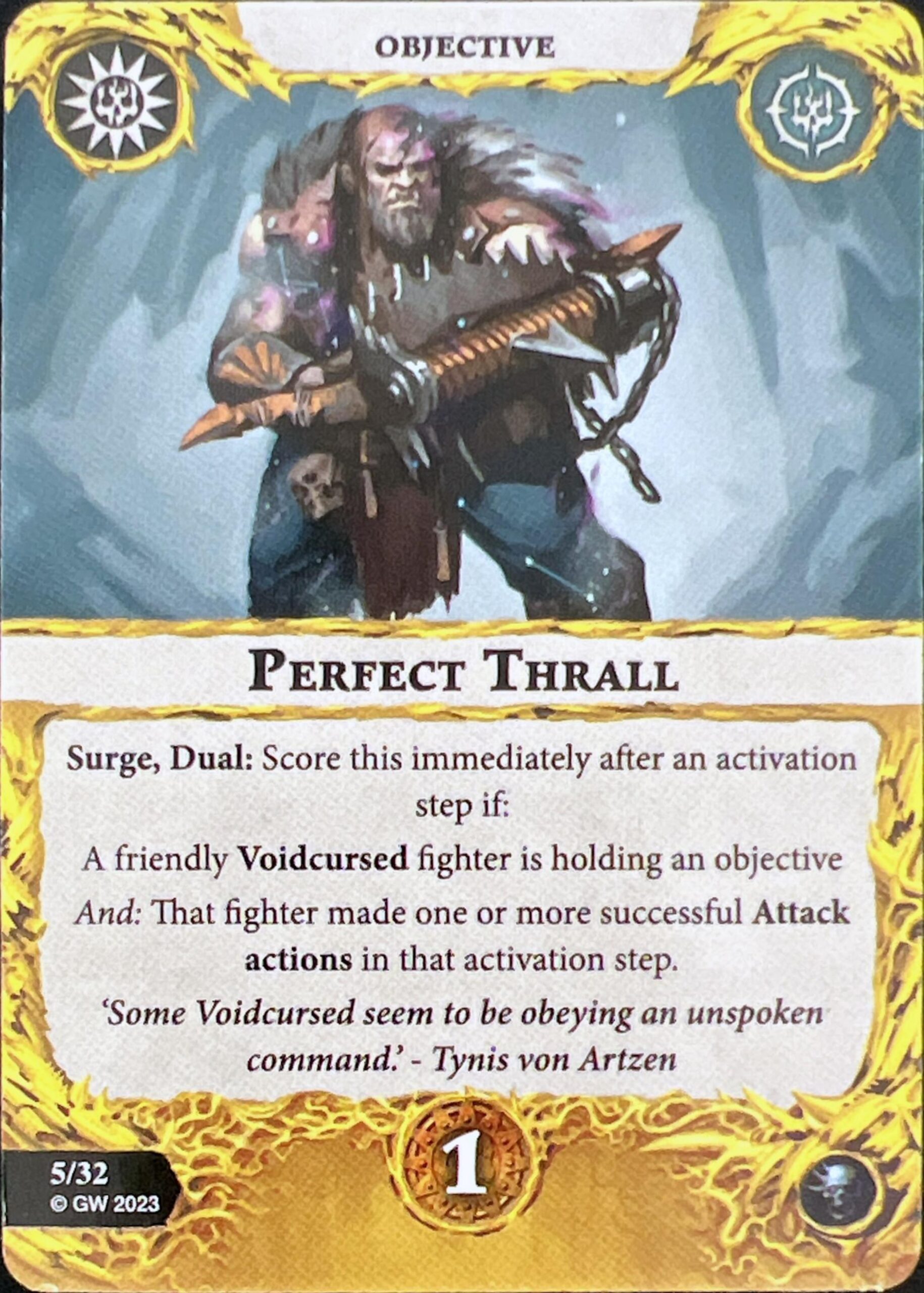
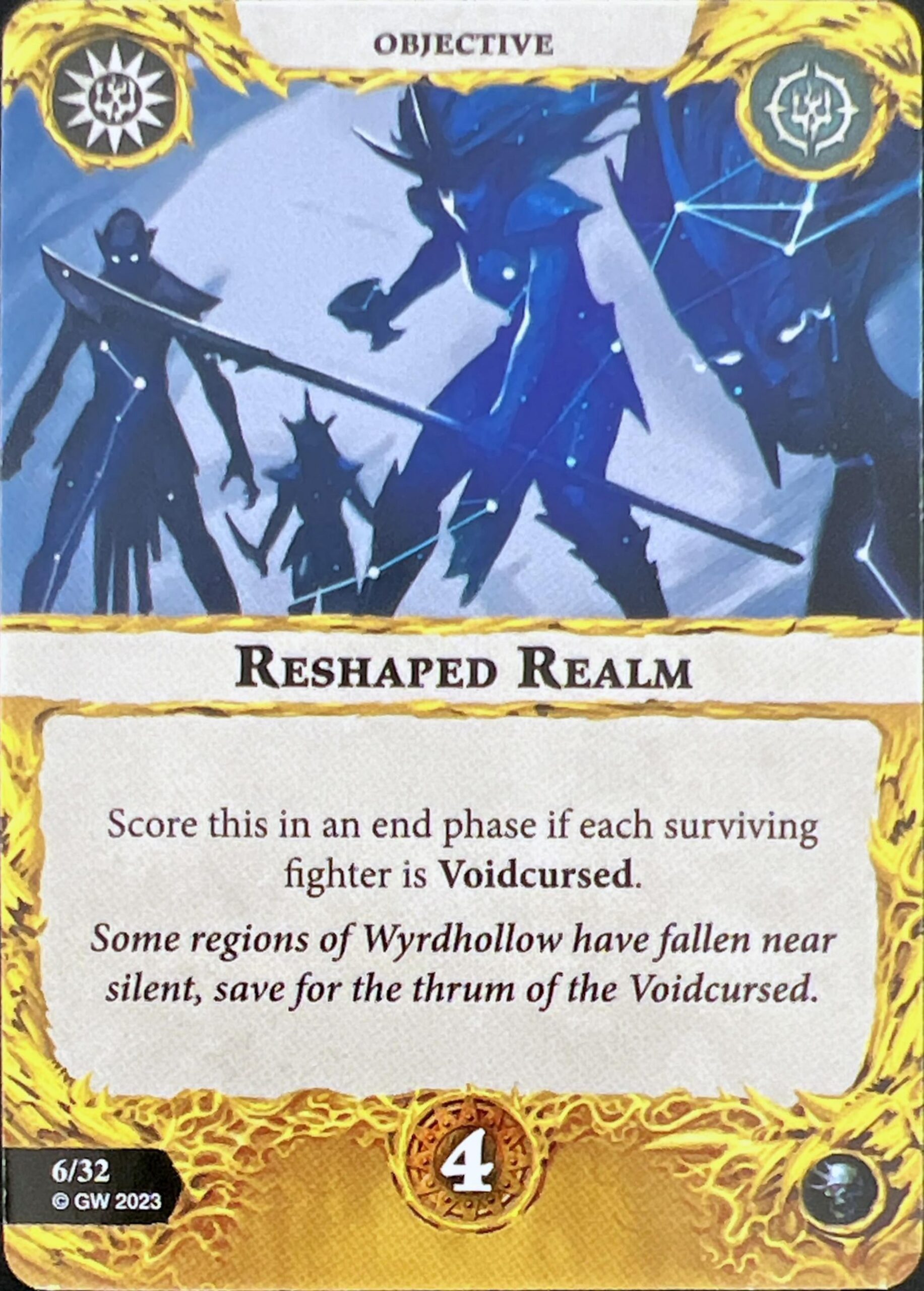
For our next one, the irony (is irony the right word?) is not lost on me that a voidcursed Hrothgorn is depicted wielding a trap launcher that he would be unable to fire due to the restrictions of being voidcursed… Perfect Thrall is a surge that scores for making a successful attack action with a voidcursed fighter holding an objective at the end of the activation. While the attack needs to be made during an activation step, the wording is such that (given prior FAQs) you can score this while using post-activation push reactions to get onto that objective, or even pushing off one after making the attack from the objective. In any case, I think this one is pretty decent, sort of [![]() Bold Conquest]
Bold Conquest]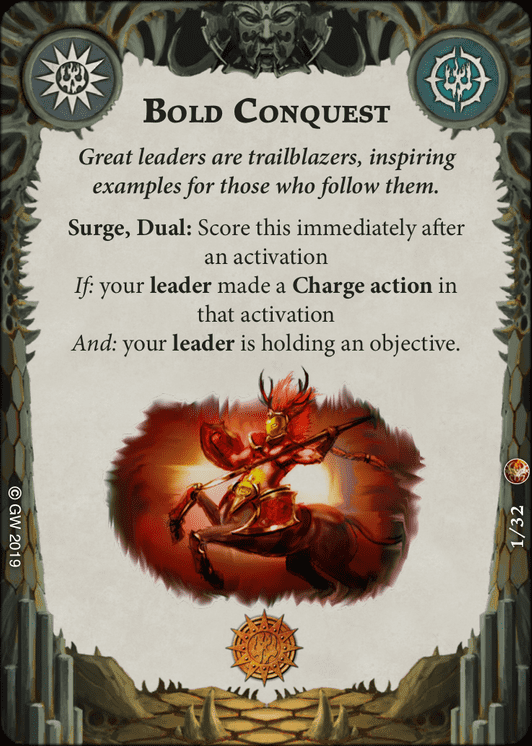 vibes. It is hindered a bit by the fact that you can’t make Range 3+ attack actions with voidcursed fighters, but just needing the attack to succeed is relatively matchup-independent, whereas needing a kill is not. Additionally, the fact that you cannot be driven back while voidcursed can help you stay on and keep swinging from an objective when needed. I like it as an option for flex warbands that want to be occupying tokens anyways, just throw in a few pokey sticks like [
vibes. It is hindered a bit by the fact that you can’t make Range 3+ attack actions with voidcursed fighters, but just needing the attack to succeed is relatively matchup-independent, whereas needing a kill is not. Additionally, the fact that you cannot be driven back while voidcursed can help you stay on and keep swinging from an objective when needed. I like it as an option for flex warbands that want to be occupying tokens anyways, just throw in a few pokey sticks like [![]() Cursed Boarding Pike]
Cursed Boarding Pike]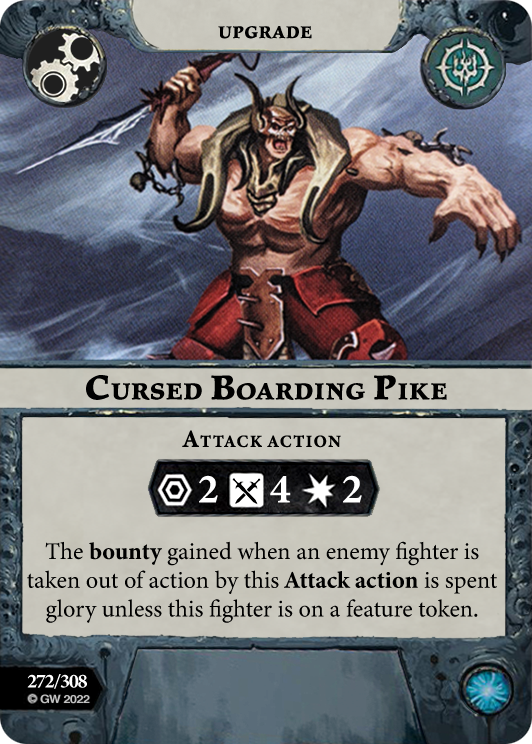 and I think it feels pretty good.
and I think it feels pretty good.
Power Ceiling: 2, Consistency: 2, Universality: 3
Reshaped Realm is a whopping 4-glory end phase for each surviving fighter (both friendly and enemy) being voidcursed. While this is very much on-theme for the idea of spreading the curse, it is also going to be quite difficult to pull off. There are only a few ways to make enemy fighters become voidcursed, so I’m not sure you can ever rely on making this happen outside of the mirror match. Best case scenario, you are running a 3-4 fighter warband yourself and are capable of killing most of your opponent’s fighters (again, very matchup-dependent) to minimize the number of targets to spread the curse to. Even in such a scenario, that’s still a pretty difficult needle to thread, I think this generally seems more thematic than good. 4 glory though…
Power Ceiling: 3, Consistency: 1, Universality: 1
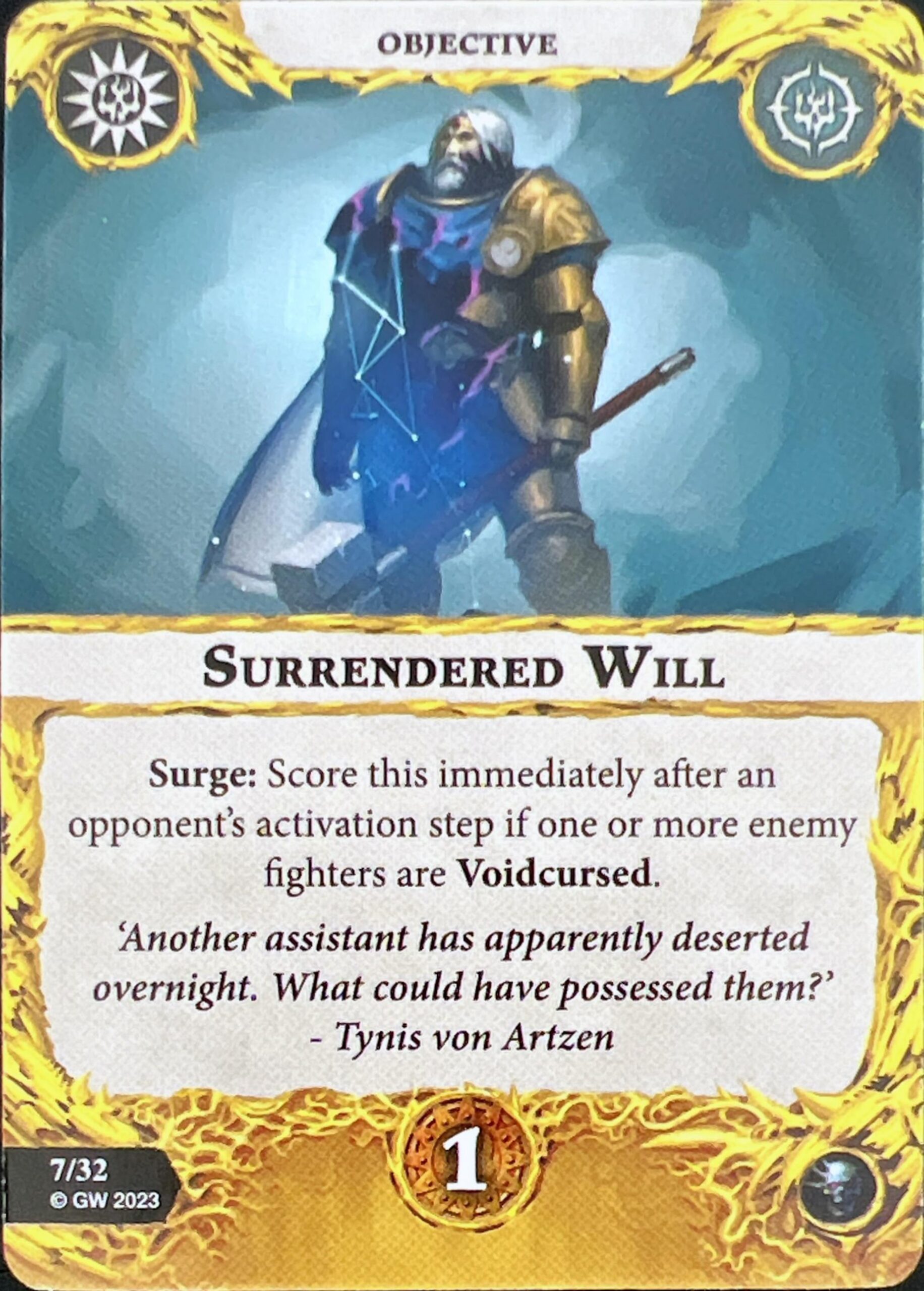
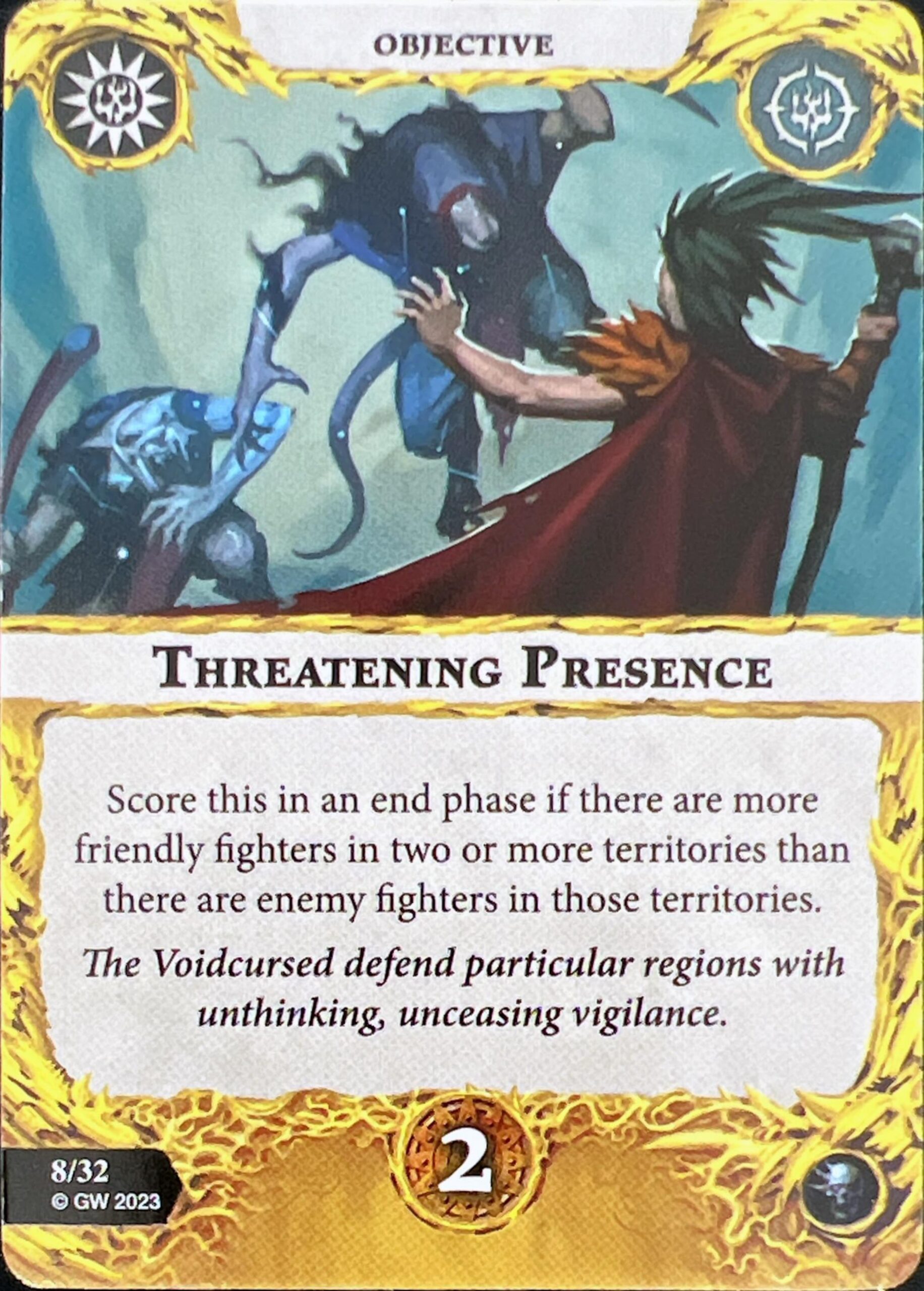
Surrendered Will is a surge scored immediately after an activation if one or more enemy fighters are voidcursed. Given the idea of the deck, this seems relatively doable, but is once again a card that plays much better into Rivals or Nemesis than Championship. The more “make fighter voidcursed” stuff you can take, the more dependable that draw becomes. Cheating ahead a bit, there are, in the deck, 4 gambits and 2 upgrades capable of spreading the curse to enemy fighters. Of those, I would say only 2-3 gambits and 1 of the upgrades are all that dependable for actually making the curse happen. When we are talking about a surge that may end up in your opening hand, that is a pretty difficult prospect. Of course, there is the chance you might just be laughing in the mirror match as you both pull this score for free, but you obviously can’t bet on that. You have a bit less control over this than I’d like, despite the fact that, if in its most executable state, this is nice passive and relatively trivial.
Power Ceiling: 3, Consistency: 1, Universality: 2
Threatening Presence is our first (and only) objective card in the deck that does not reference the voidcursed keyword. It is simply a 2-glory end phase for having more friendly fighters in two or more territories than there are enemy fighters in those territories. I’m assuming this means you need to have more in each of those territories, rather than just picking two territories and counting up the sum of fighters between them, but this still strikes me as being really good for horde warbands, especially those with high movement/push economy. Even on a passive setup, a warband like Thorns or Sepulchral Guard could just shunt a couple of fighters into no one’s territory and rely on their sheer number of bodies chilling in their own territory to score this. Similarly, some aggro warbands like Kainan’s Reapers are trying to satisfy these types of conditions with [![]() Taking Advantage]
Taking Advantage] and [
and [![]() Lengthening Shadows]
Lengthening Shadows] anyway, and would just need to supplement with some no one’s territory supremacy. Obviously not the most ideal choice for 3-4 fighter warbands, but seems like it should be nearly automatic for a lot of horde warbands while still forcing some contest in the mid-board for the no one’s territory condition (presuming that might be easier than having more in your and enemy territory). I like this one quite a bit, it gives you some edge to fight back against the elite warbands that tend to be very powerful in the Nemesis meta too.
anyway, and would just need to supplement with some no one’s territory supremacy. Obviously not the most ideal choice for 3-4 fighter warbands, but seems like it should be nearly automatic for a lot of horde warbands while still forcing some contest in the mid-board for the no one’s territory condition (presuming that might be easier than having more in your and enemy territory). I like this one quite a bit, it gives you some edge to fight back against the elite warbands that tend to be very powerful in the Nemesis meta too.
Power Ceiling: 3, Consistency: 2, Universality: 2
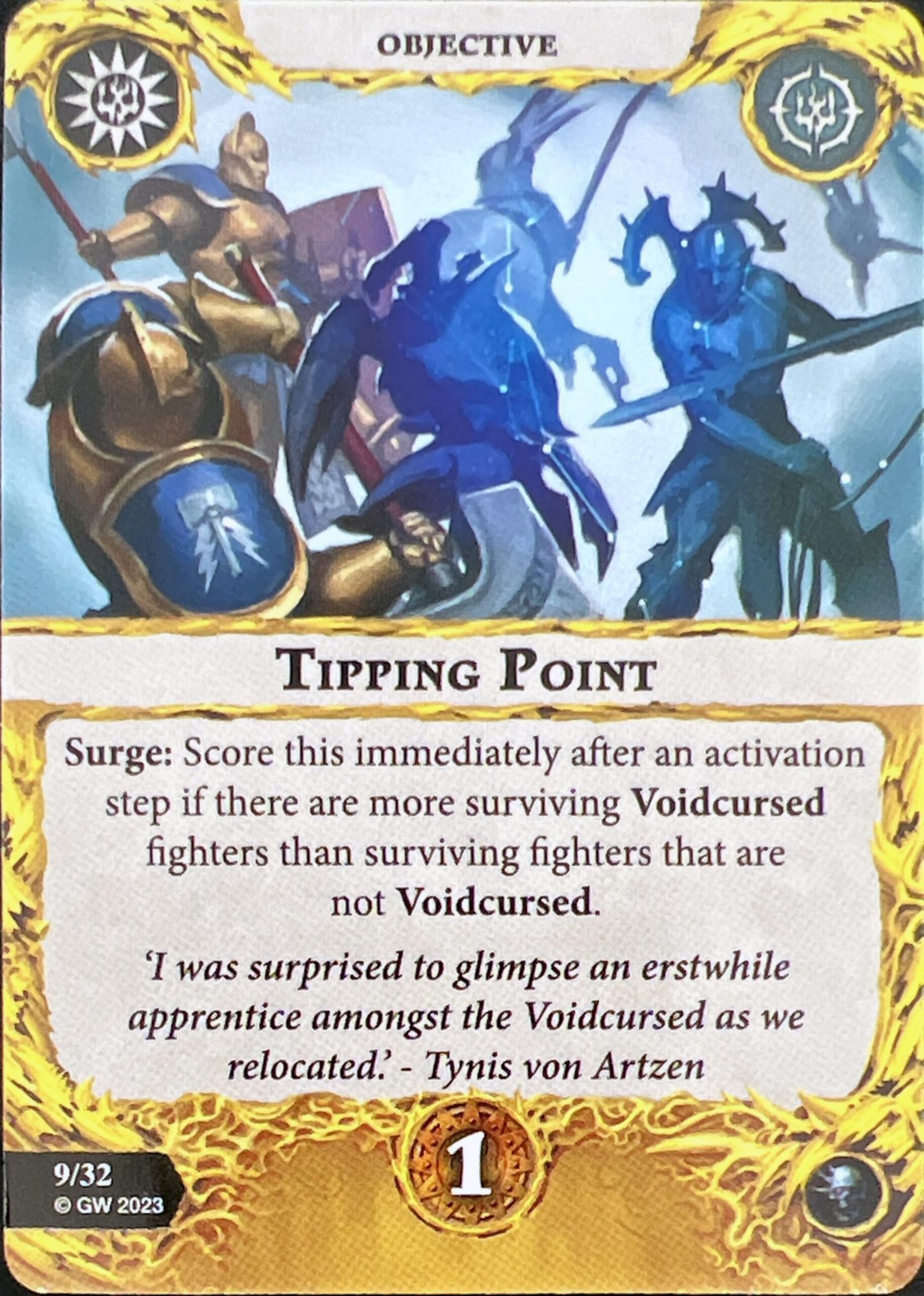
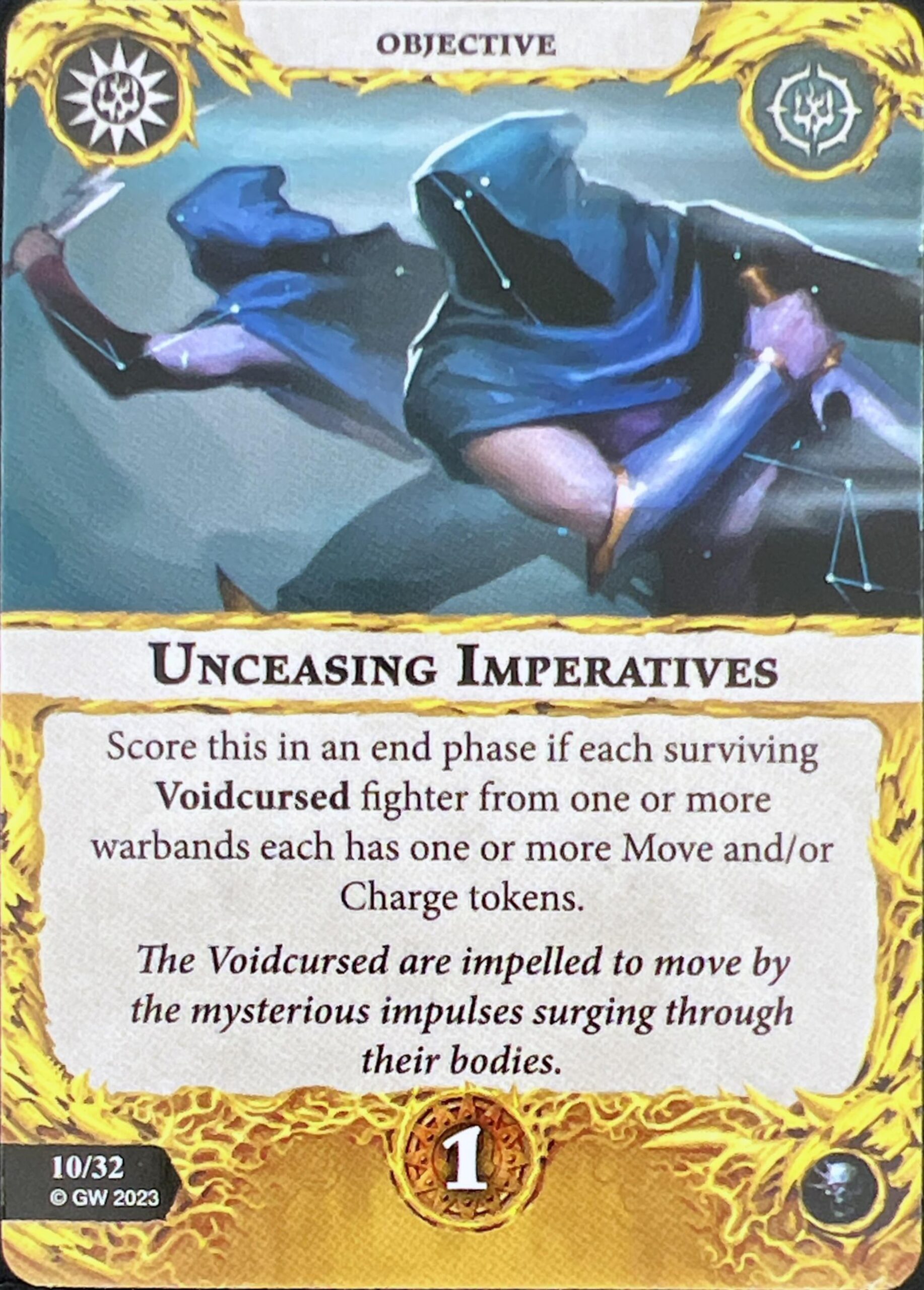
Our next objective is Tipping Point, a surge which scores immediately after an activation if there are more surviving voidcursed fighters than those who are not voidcursed. If you are aiming to make Reshaped Realm work, this is a natural progression throughout the course of the game, but it once again becomes fairly matchup-dependent. If your opponent is playing a horde warband, this requires a lot of killing and/or voidcursing to accomplish and will not be consistently scoreable until the later rounds. However, if both players are playing elite warbands, suddenly you are looking at just a few power cards and maybe 1 or 2 kills to cover it, then maybe it feels a lot better.
Power Ceiling: 2, Consistency: 1, Universality: 2
Unceasing Imperatives is a 1-glory end phase for each surviving voidcursed fighter from one or more warbands having one or more Move or Charge tokens. Even if you are not leaning much into the power card support for spreading the curse, this should still be fairly easy to accomplish, as long as you are able to keep alive the 1 voidcursed fighter you start with each round. Even if that’s not possible, several of the “make a fighter voidcursed” cards are flexible enough to be used on fighters from either warband to score this. Interestingly enough, this actually becomes more difficult to pull off the more you spread the curse, so a bit of weird anti-synergy with the other objectives in the deck. If you are a warband with some movement economy (and this power deck does provide you some, even if you don’t have it innately), could still be doable even if there are a lot of cursed fighters. Pretty solid 1-glory card here, you should be able to score it most games.
Power Ceiling: 1, Consistency: 3, Universality: 3
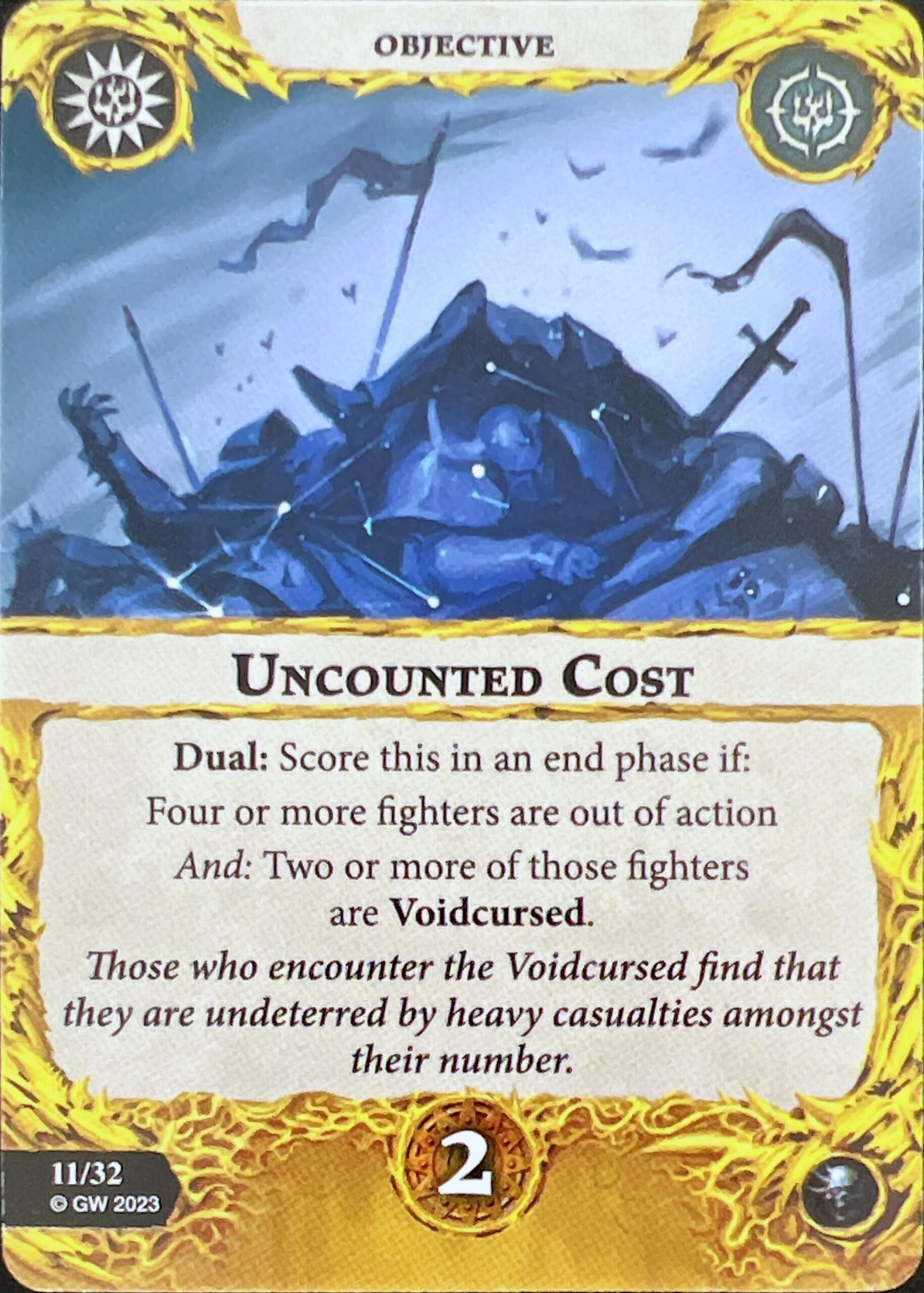
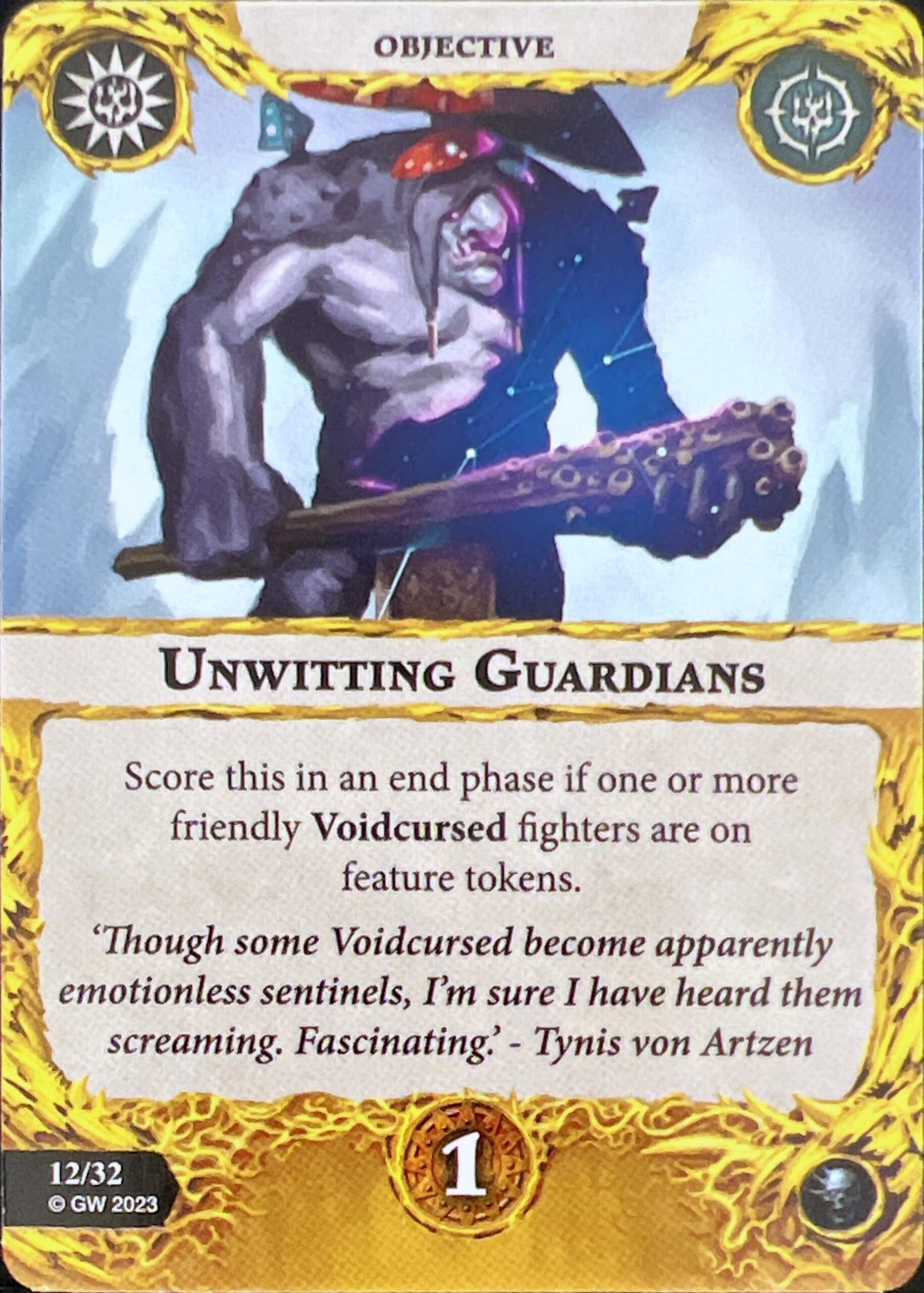
Next up is a mini [![]() Pure Carnage]
Pure Carnage]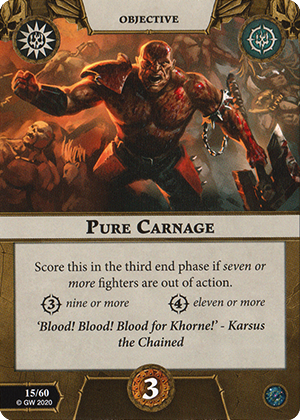 for 2 glory in Uncounted Cost, scoring in an end phase if 4 or more fighters are out of action and two or more of those fighters are voidcursed. In addition to [
for 2 glory in Uncounted Cost, scoring in an end phase if 4 or more fighters are out of action and two or more of those fighters are voidcursed. In addition to [![]() Pure Carnage]
Pure Carnage] , we’ve seen variations of this on warbands in the past with cards like [
, we’ve seen variations of this on warbands in the past with cards like [![]() Collateral Damage]
Collateral Damage]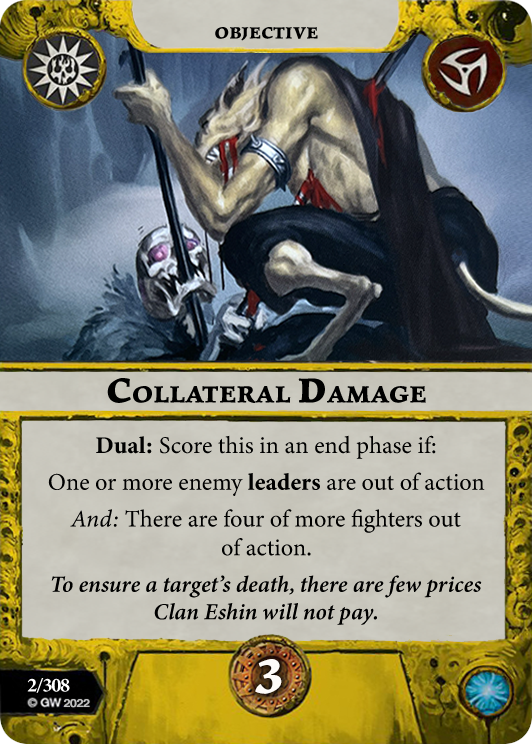 , [
, [![]() Kill! Kill Again!]
Kill! Kill Again!] , [
, [![]() Khorne Cares Not]
Khorne Cares Not]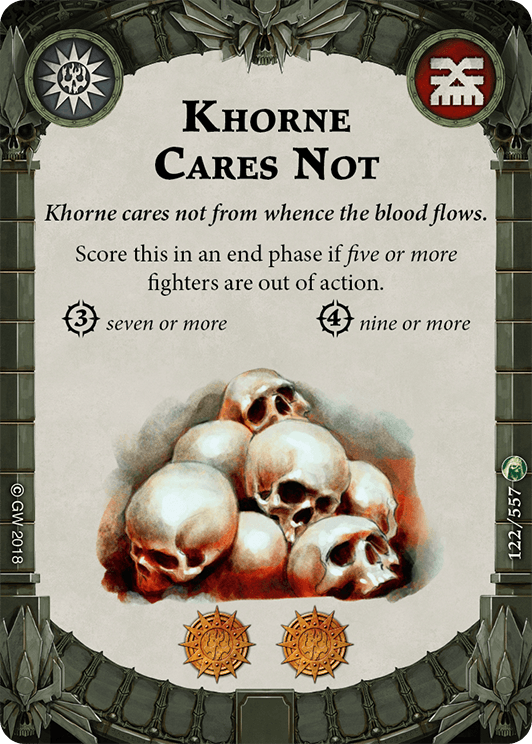 , [
, [![]() Survival of the Fittest]
Survival of the Fittest]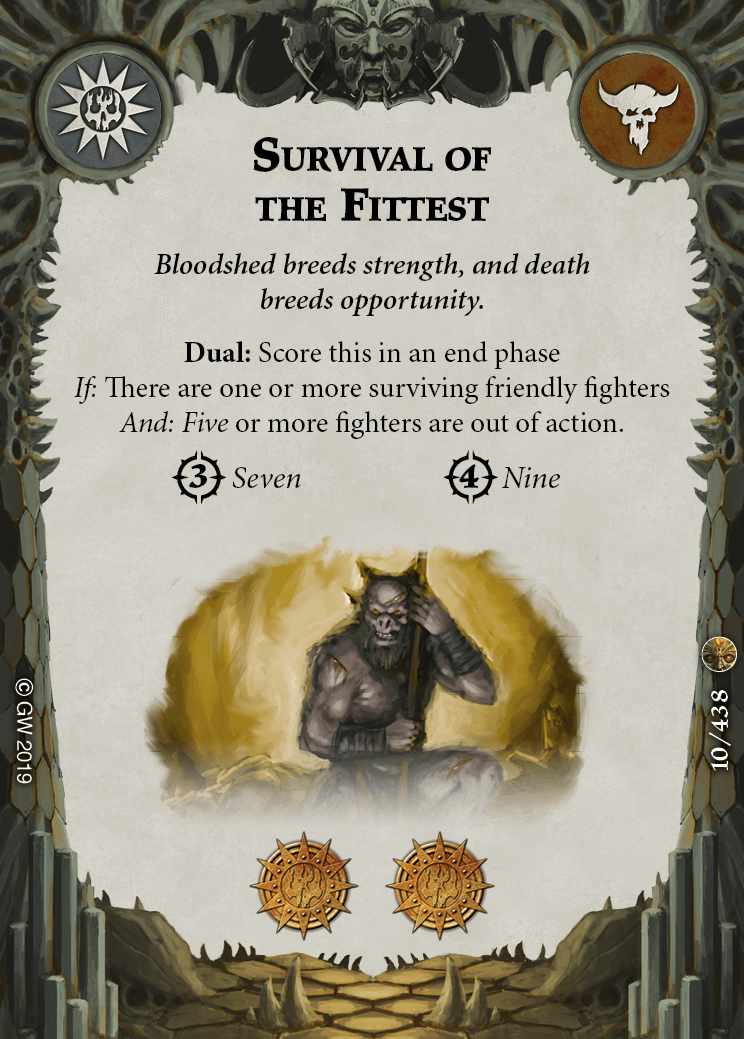 , and others I am probably forgetting to mention. In any of those cases, the ability to build in this redundancy of scoring condition is always an attractive prospect, especially given that these kind of redundancies can open up potential for some massive 3rd end phases even if most or all of your warband has already been wiped off the table. It also really alleviates your Round 3 burden in general when you can more reliably count your end phase glory before the activations even play out. This piece of mind does come with the cost of the card being an unlikely score in Round 1, so you can’t necessarily rely on just packing in tons of these end phase cards, but having 2 or 3 feels like a pretty decent sweet spot to streamline your aggro gameplan, especially if you’ve been struggling with your end phase glory.
, and others I am probably forgetting to mention. In any of those cases, the ability to build in this redundancy of scoring condition is always an attractive prospect, especially given that these kind of redundancies can open up potential for some massive 3rd end phases even if most or all of your warband has already been wiped off the table. It also really alleviates your Round 3 burden in general when you can more reliably count your end phase glory before the activations even play out. This piece of mind does come with the cost of the card being an unlikely score in Round 1, so you can’t necessarily rely on just packing in tons of these end phase cards, but having 2 or 3 feels like a pretty decent sweet spot to streamline your aggro gameplan, especially if you’ve been struggling with your end phase glory.
Power Ceiling: 3, Consistency: 2, Universality: 2
The final objective in the set is Unwitting Guardians, which scores for 1 glory in the end phase if one or more friendly voidcursed fighters are on a feature token. While not quite so easy as Unceasing Imperatives, I think it is pretty close. Soulraid, for example, could make Spinefin voidcursed and plop it on a token wherever for their scoring. The “cannot be driven back” aspect of the plot will once again come into play here too, as you can end up being pretty difficult to dislodge without lots of enemy push cards. Not having a restriction on which territory the feature token needs to be in also makes for an easier time scoring this passively, I think you could definitely consider this in your 1-glory end phase slot, just make sure to take enough pushes or other hold tech like [![]() Drifting Tides]
Drifting Tides]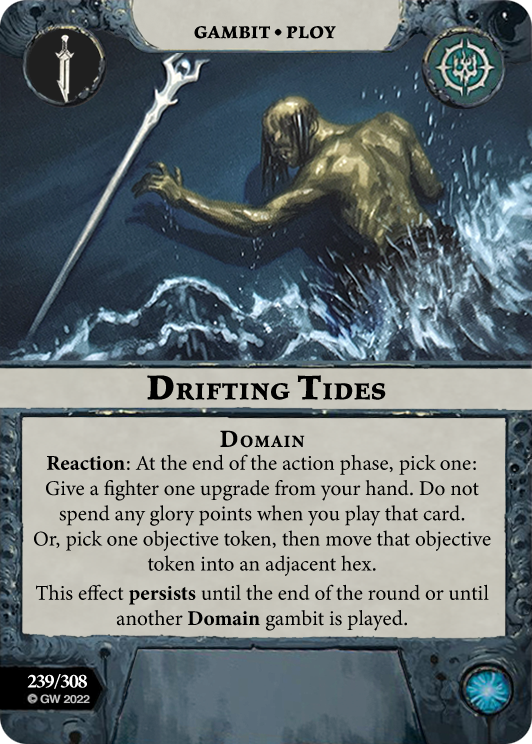 to keep yourself a bit more disruption-proof.
to keep yourself a bit more disruption-proof.
Power Ceiling: 1, Consistency: 2, Universality: 3
Our Favorites
- Mark: Threatening Presence
- Aman: Threatening Presence
- Zach: Threatening Presence (no, this is not a typo, we legitimately all picked the same card!)
Gambits
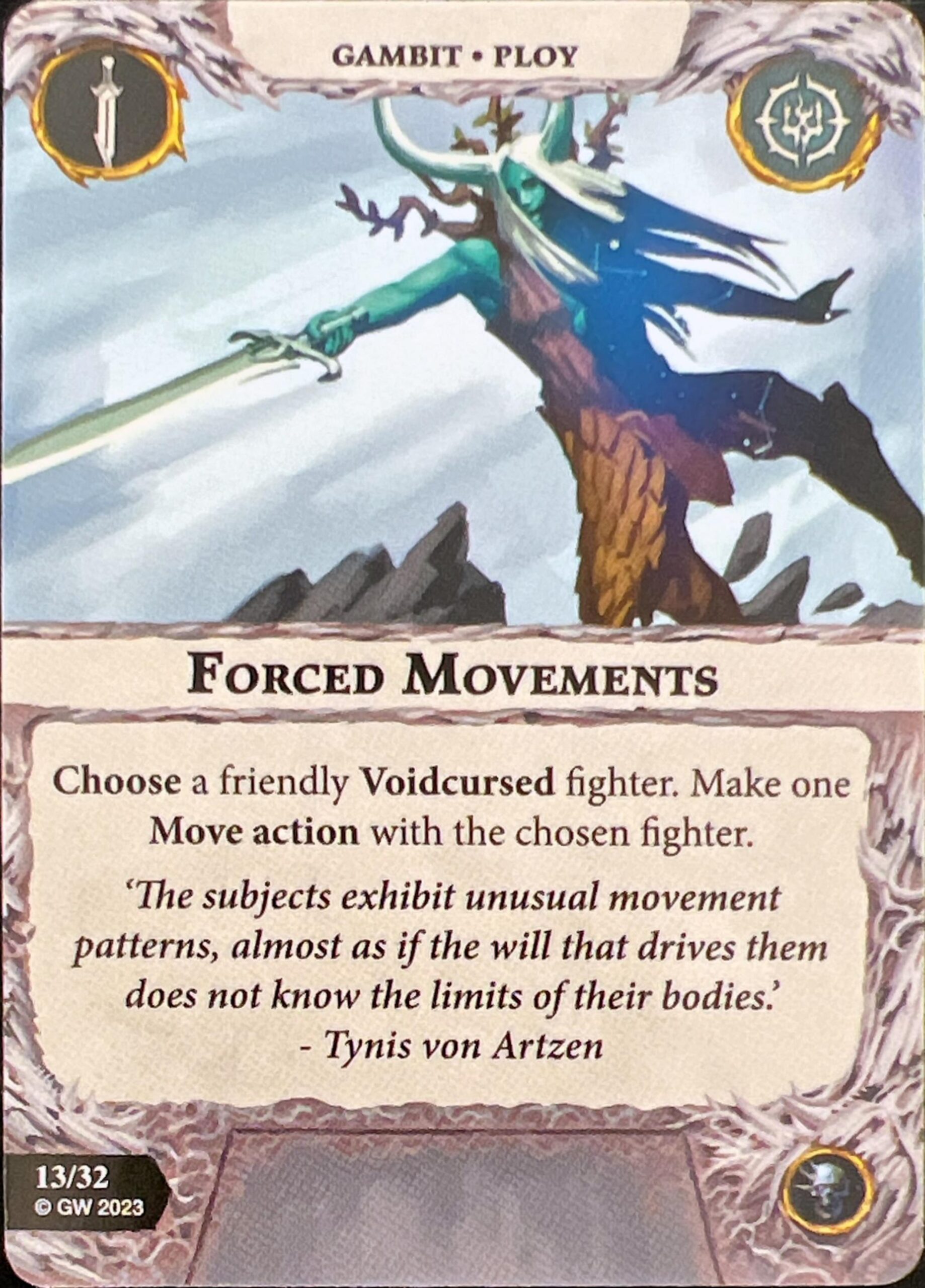
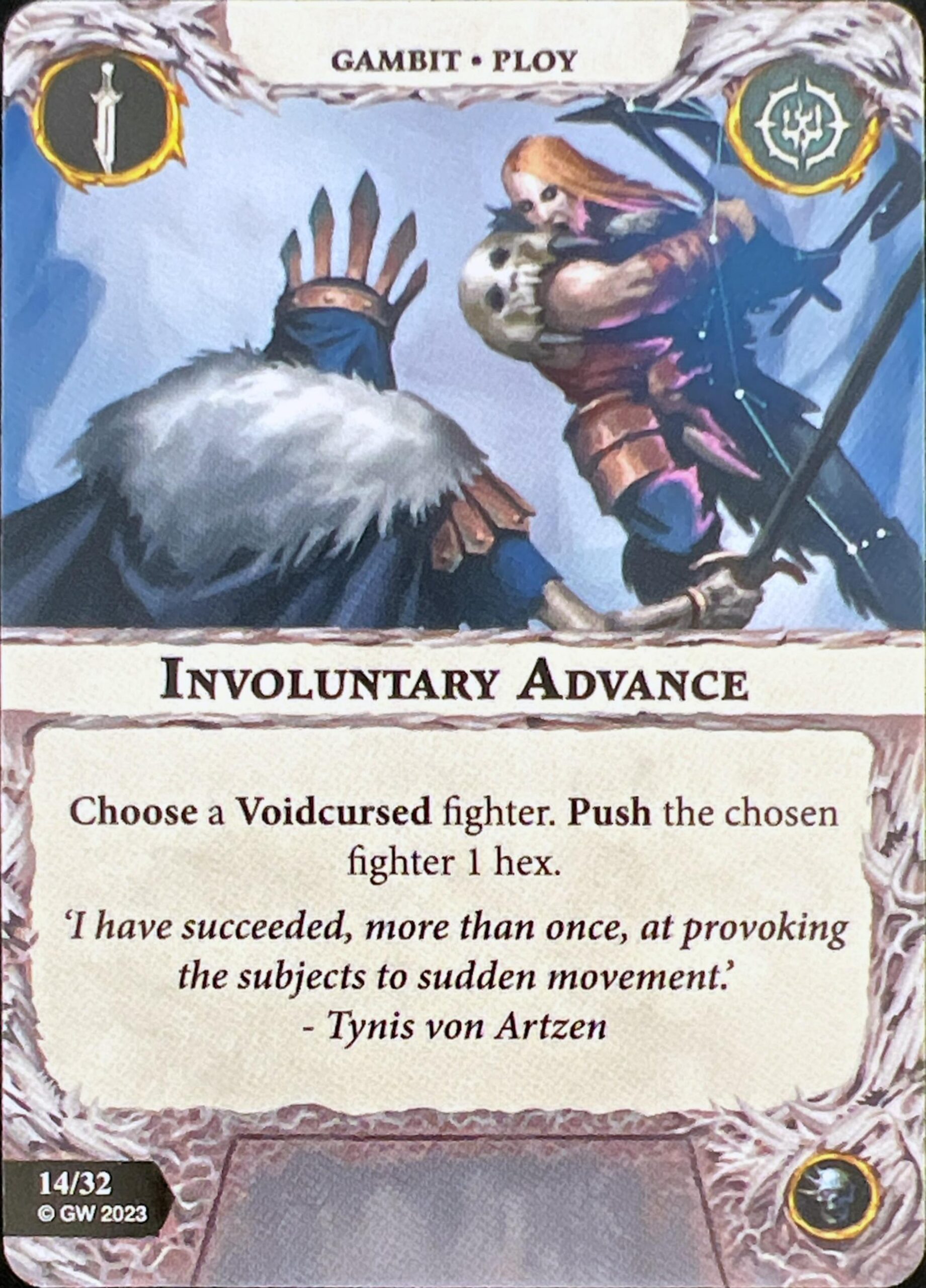
I’ll spoil right now that all 10 gambits in the set make some reference to being voidcursed, so it’s helpful to know ahead of time that you’ll need to be leaning into the keyword at least to some extent if you plan to take any of them. For our first card, we have Forced Movements, which allows you to make a move action with a friendly voidcursed fighter in the power step. While not quite as powerful as a card like [![]() Quicksilver Advance]
Quicksilver Advance]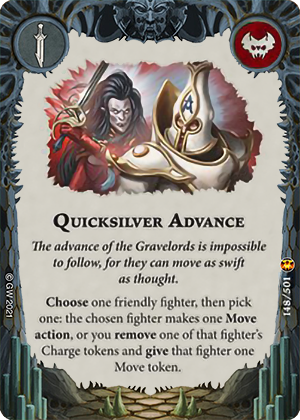 , the ability to suddenly have moved in a support, or reposition a fighter onto a feature token, can definitely be significant in terms of controlling the board state. Warbands with multi-move synergy such as Reapers, DKK, or Gitz, can also make use of this in power steps to accomplish massive positional advantages without even having to burn an activation. You’ll obviously need to be conscious of exactly when you plan to use these types of cards, as the move tokens still limit you from making charges, but if your goal is really only to maintain your positioning, you might not need to care about this downside anyway and just treat this as a push equivalent to your Move characteristic. Definitely some good incentive to take a couple of the voidcurse tech cards, this one is pretty solid. The downside, such as it is, would probably be that it means you need to consume a few other power card slots on making sure you have voidcursed fighters around to be able to make use of this, especially in terms of giving you the flexibility to do so with more than one fighter.
, the ability to suddenly have moved in a support, or reposition a fighter onto a feature token, can definitely be significant in terms of controlling the board state. Warbands with multi-move synergy such as Reapers, DKK, or Gitz, can also make use of this in power steps to accomplish massive positional advantages without even having to burn an activation. You’ll obviously need to be conscious of exactly when you plan to use these types of cards, as the move tokens still limit you from making charges, but if your goal is really only to maintain your positioning, you might not need to care about this downside anyway and just treat this as a push equivalent to your Move characteristic. Definitely some good incentive to take a couple of the voidcurse tech cards, this one is pretty solid. The downside, such as it is, would probably be that it means you need to consume a few other power card slots on making sure you have voidcursed fighters around to be able to make use of this, especially in terms of giving you the flexibility to do so with more than one fighter.
Power Ceiling: 2, Consistency: 2, Universality: 2
Involuntary Advance allows you to push a voidcursed fighter (friendly or enemy) 1 hex. I often use [![]() Sidestep]
Sidestep]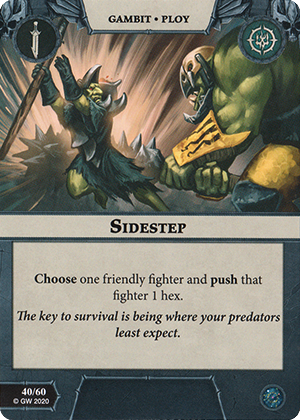 as a bit of a measuring stick for pushes and certainly, in regard to the friendly push angle, this is not quite as good. However, I think the potential upside of instead using this as a [
as a bit of a measuring stick for pushes and certainly, in regard to the friendly push angle, this is not quite as good. However, I think the potential upside of instead using this as a [![]() Distraction]
Distraction]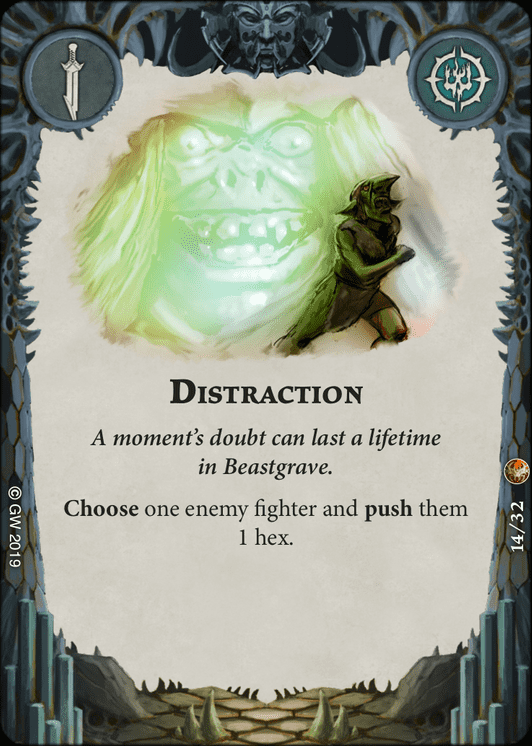 (of course, in conjunction with cards that can apply the curse to enemy fighters) probably make this worth taking unless you don’t plan to take many of the cards from the Rivals deck. The degree to which you want to lean in will obviously vary from warband-to-warband, but the synergy and the effect are both good, especially since we all remember how good an enemy push can be without range, positional, or directional limitations.
(of course, in conjunction with cards that can apply the curse to enemy fighters) probably make this worth taking unless you don’t plan to take many of the cards from the Rivals deck. The degree to which you want to lean in will obviously vary from warband-to-warband, but the synergy and the effect are both good, especially since we all remember how good an enemy push can be without range, positional, or directional limitations.
Power Ceiling: 3, Consistency: 2, Universality: 2
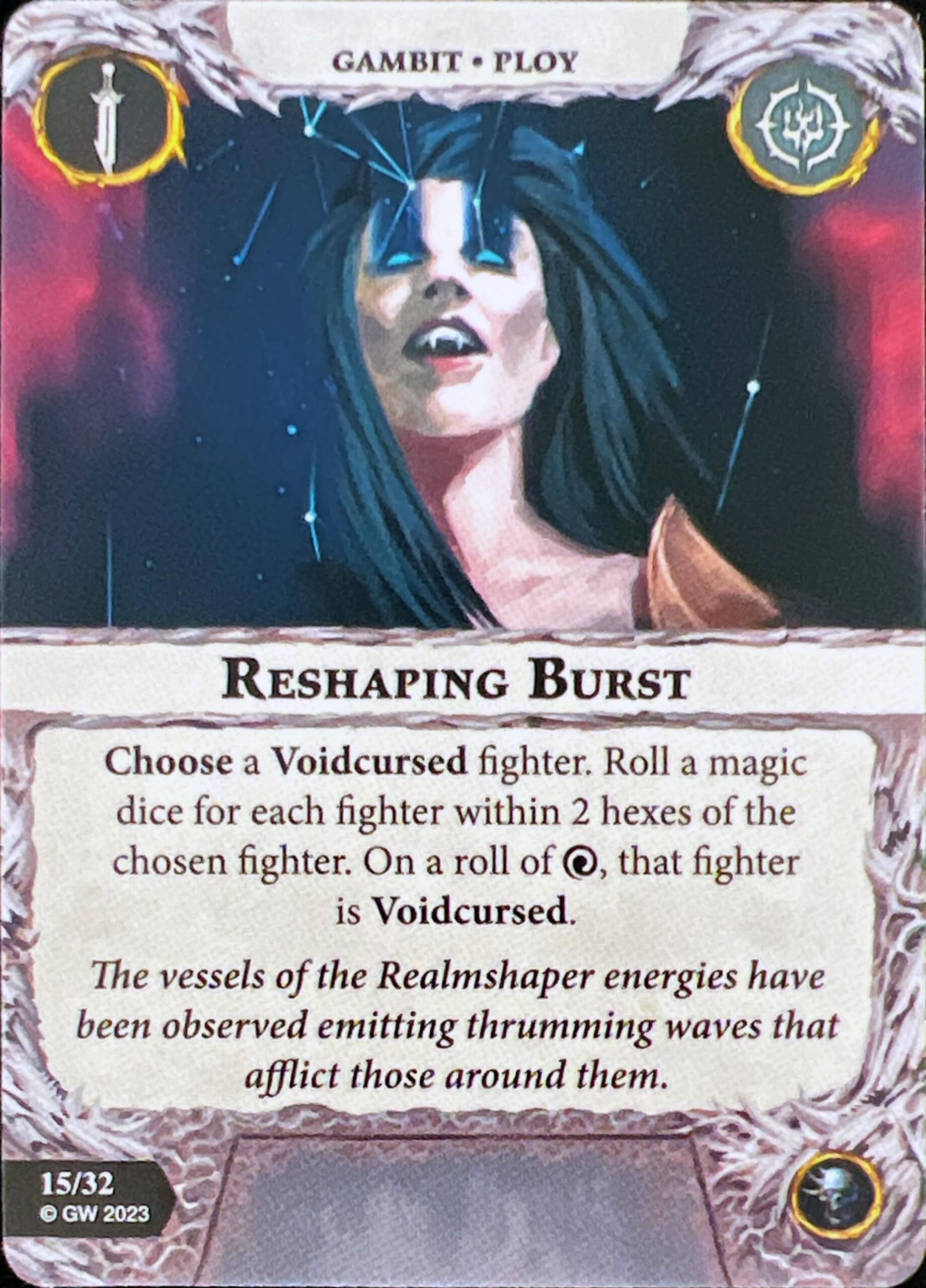
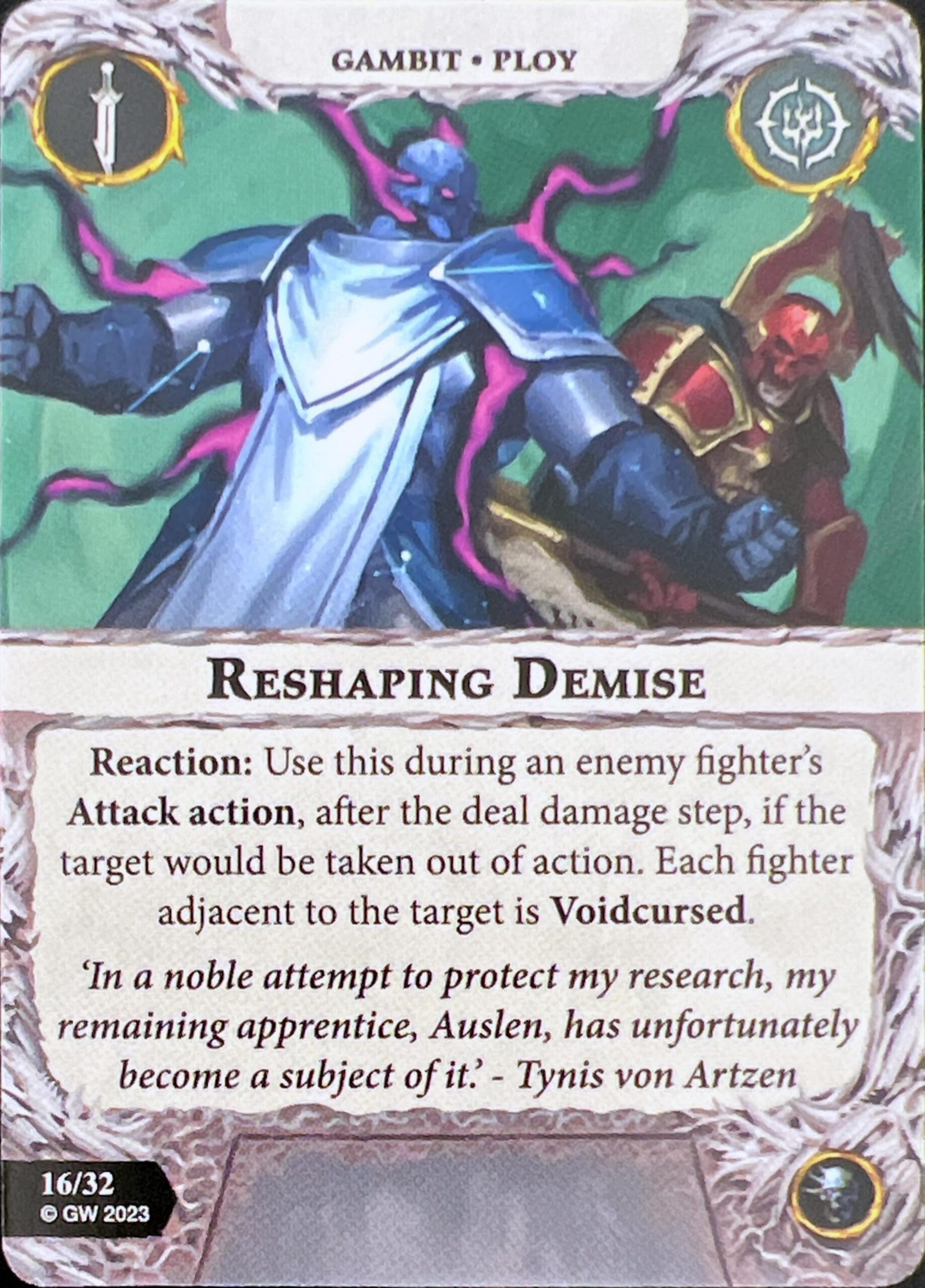
Next up is Reshaping Burst, which lets you roll a magic die for each fighter within 2 hexes of a voidcursed fighter, cursing each fighter on a roll of swirly. If this worked on lightning instead, maybe you start considering it, but a 33% to work is not the kind of control I am looking for in terms of distributing the curse. If you really don’t care who takes it, this can be nice to splash onto a bunch of fighters at once (potentially), but odds are that there is a particular enemy fighter you really want to curse, or a particular friendly fighter you do/don’t want to curse. Without real agency in making sure that curse does or does not happen, I’m not sure I can see taking this one, and even if you roll hot and it splashes to all your intended targets, you still need other cards to play off the fact that you’ve cursed so many fighters, although bricking a fighter like Deintalos, if you can get him, could have a game-altering effect.
Power Ceiling: 2, Consistency: 1, Universality: 1
Reshaping Demise allows you to react during an enemy fighter’s attack action that would take the target out of action to voidcurse each fighter adjacent to the target. If you are looking to splash the curse onto several fighters at once, I think this is my preferred option, especially on horde warbands like Exiled Dead that will be consistently shedding fighters anyway. The fact that you can do it from any fighter and not just a voidcursed one just makes it a lot more flexible and it acts as pretty solid surprise tech. You can even pack in cards like [![]() Countercharge]
Countercharge]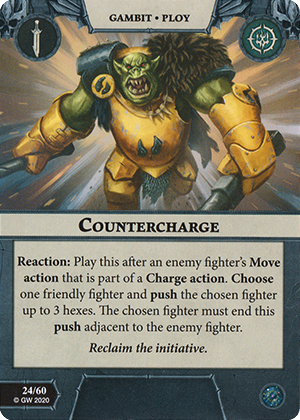 or some of the other movement tech in this deck to make the splash more reliable and also surprise fighters attacking at Range 2+. Dangling a fighter in order to potentially curse a really desirable target like Deintalos, Skritch, etc. could end up being a game-winning trade. Warbands with fighters who really don’t want that key fighter getting cursed are going to need to know this Rivals deck inside and out to avoid putting those fighters in situations where they are at risk to these effects.
or some of the other movement tech in this deck to make the splash more reliable and also surprise fighters attacking at Range 2+. Dangling a fighter in order to potentially curse a really desirable target like Deintalos, Skritch, etc. could end up being a game-winning trade. Warbands with fighters who really don’t want that key fighter getting cursed are going to need to know this Rivals deck inside and out to avoid putting those fighters in situations where they are at risk to these effects.
Power Ceiling: 2, Consistency: 2, Universality: 2
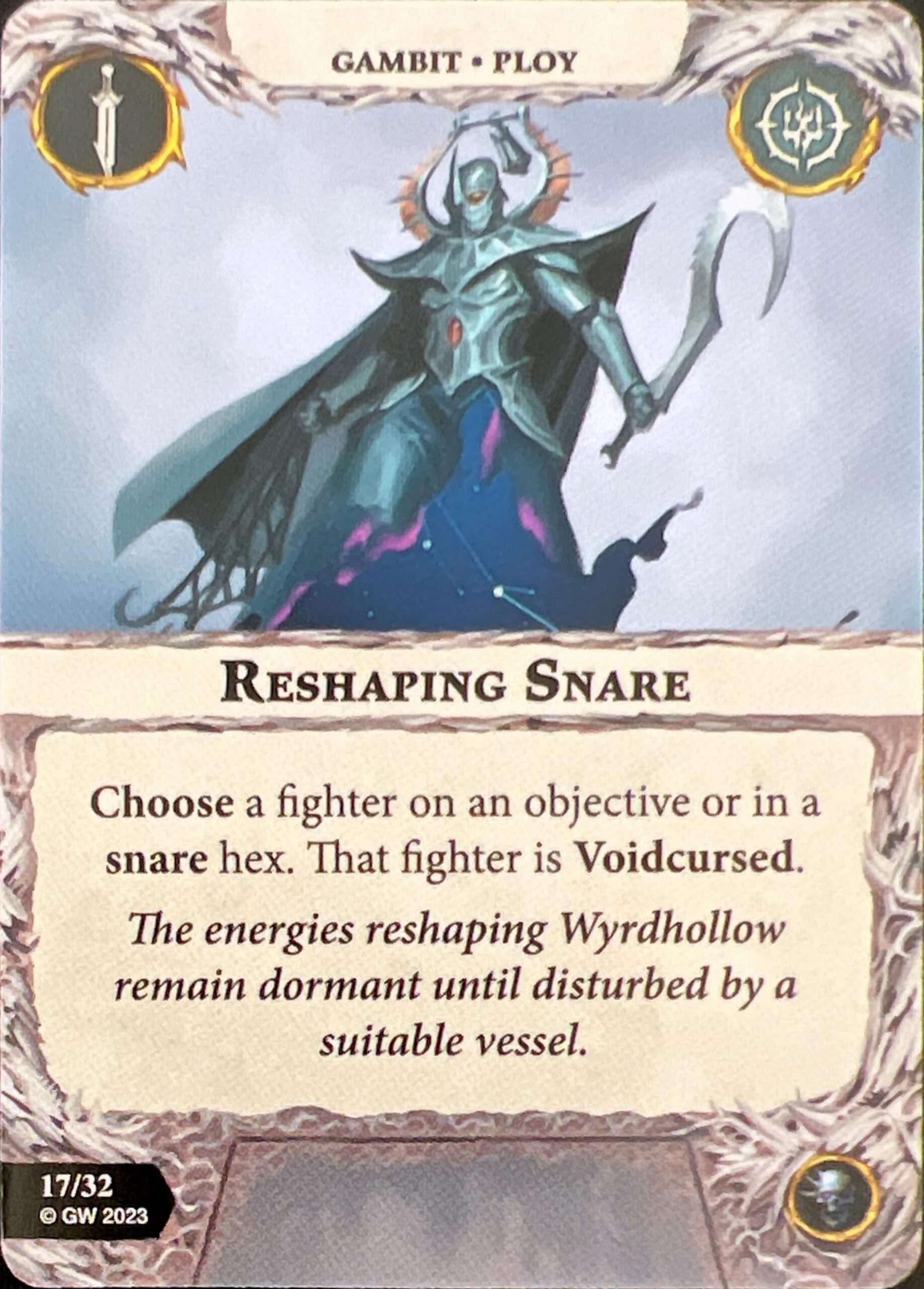
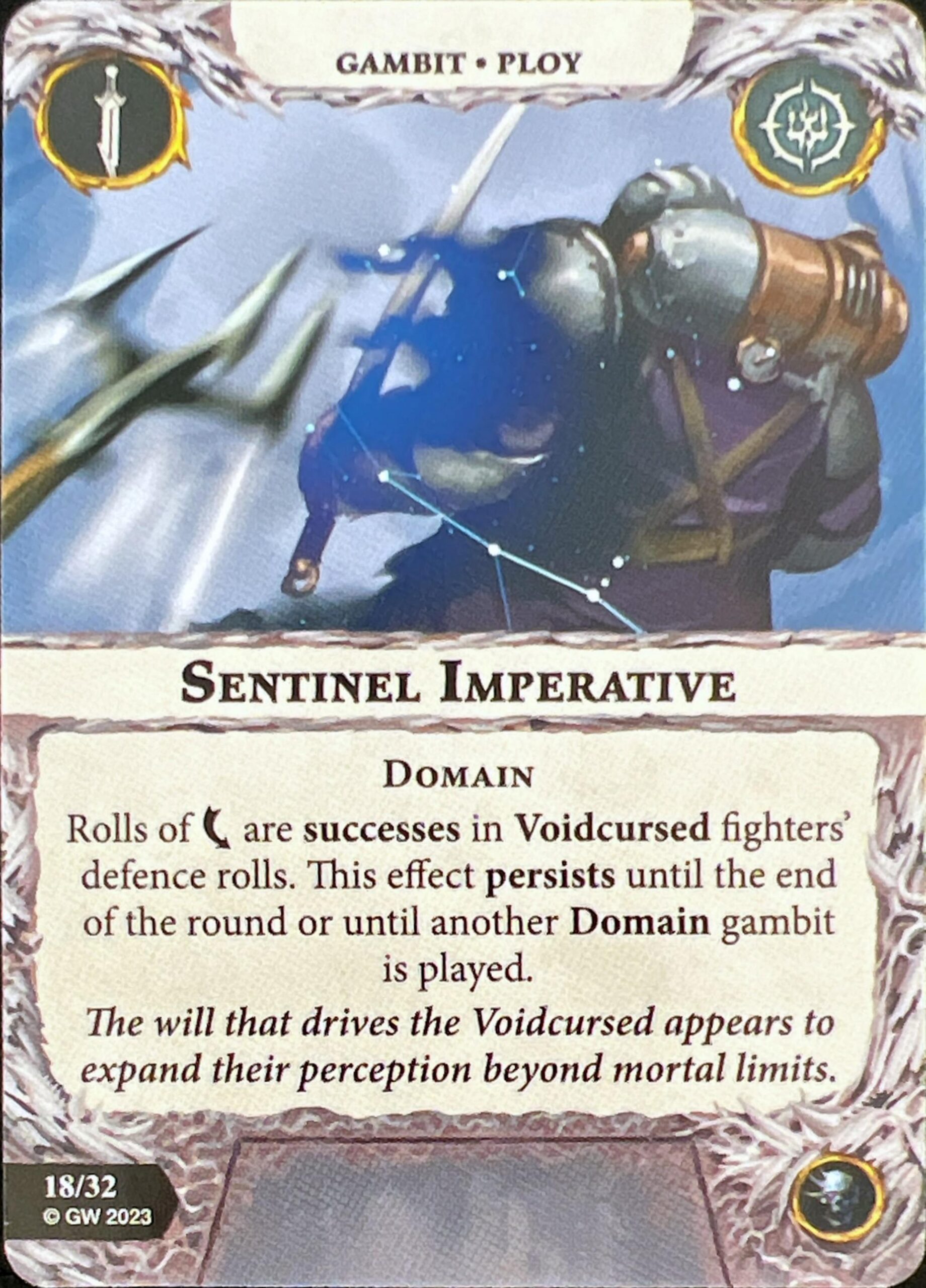
Reshaping Snare is the last of the 3-card miniseries, applying voidcursed to a fighter on an objective or snare hex. The ability to pick enemy fighters here is definitely the major upside of the card. You drop this on an enemy’s Otapatl and suddenly that 3-Dodge, crit-piping nuisance is just on 1 Shield and can’t even fight back. Similarly, I’ve seen several Exiled Dead players running [![]() Sorcerous Treasure-hunter]
Sorcerous Treasure-hunter]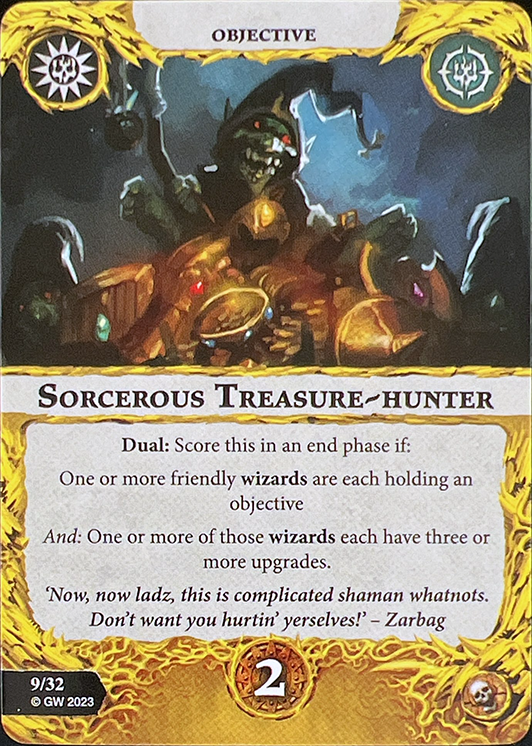 and landing Deintalos on objectives, and we’ve already discussed how debilitating the keyword can be on him. I feel like, of the 3, this has the most player agency in terms of when you want the effect to take place. Even if you can’t manage to snare that key target from your opponent’s warband, presumably you are playing the deck for the inherent benefits to your own playstyle as well, so it’s not too bad if you just have to pick a friendly fighter you want to keep holding an objective, for example.
and landing Deintalos on objectives, and we’ve already discussed how debilitating the keyword can be on him. I feel like, of the 3, this has the most player agency in terms of when you want the effect to take place. Even if you can’t manage to snare that key target from your opponent’s warband, presumably you are playing the deck for the inherent benefits to your own playstyle as well, so it’s not too bad if you just have to pick a friendly fighter you want to keep holding an objective, for example.
Power Ceiling: 3, Consistency: 2, Universality: 3
Sentinel Imperative is a domain which makes Dodge count as a defensive success for all voidcursed fighters, effectively putting them on guard for the round (they already defend on shields and cannot be driven back). Obviously, this works both ways, so enemy fighters will have the same benefit that yours do. If you are a warband that takes lots of +Defence modifiers, I could see this returning some value, but otherwise the difference between 1 Shield and 1 Shield on guard is pretty marginal defensively with all these 3H+reroll or 3H+support type of attacks you can expect to see in the current meta.
Power Ceiling: 1, Consistency: 2, Universality: 2


Unbearable Energies allows you to deal 1 damage to an enemy fighter adjacent to one or more voidcursed fighters. As we know, controlled ping is quite strong and this does have a bit of a [![]() Dark Command]
Dark Command] quality to it, with the obvious caveat that savage is a far easier keyword to obtain in the first place. The fighter restriction alone should keep the card in check, but the easily manipulated ping is strong enough that you probably take it anyway, unless you are balking at the voidcursed power card package in its entirety.
quality to it, with the obvious caveat that savage is a far easier keyword to obtain in the first place. The fighter restriction alone should keep the card in check, but the easily manipulated ping is strong enough that you probably take it anyway, unless you are balking at the voidcursed power card package in its entirety.
Power Ceiling: 3, Consistency: 2, Universality: 2
Vanguard Imperative is a domain card that echoes the effect of [![]() Reckless Haste]
Reckless Haste]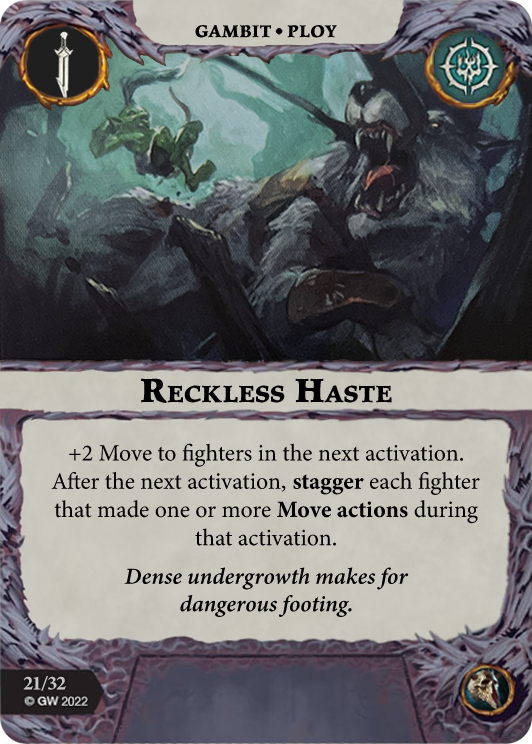 in that you give each voidcursed fighter +2 Move at the cost of a stagger token after the move action. This is mildly intriguing in the hands of a more suicide aggro build anyway to ensure you are getting all of your charges made. The most obvious synergy is probably with Exiled Dead to scoop up those juicy stagger tokens on any of your opponent’s voidcursed fighters, but Clawpack could also potentially use it to spread staggers as needed for their in-faction synergies. Other warbands with multi-move efficiency could stack this into their decks if they don’t care much for the downsides, with builds like TurboKainanTM using the extra mobility to cart their fighters into enemy territory (although in that case you have to pass up [
in that you give each voidcursed fighter +2 Move at the cost of a stagger token after the move action. This is mildly intriguing in the hands of a more suicide aggro build anyway to ensure you are getting all of your charges made. The most obvious synergy is probably with Exiled Dead to scoop up those juicy stagger tokens on any of your opponent’s voidcursed fighters, but Clawpack could also potentially use it to spread staggers as needed for their in-faction synergies. Other warbands with multi-move efficiency could stack this into their decks if they don’t care much for the downsides, with builds like TurboKainanTM using the extra mobility to cart their fighters into enemy territory (although in that case you have to pass up [![]() Conqueror’s Circlet]
Conqueror’s Circlet]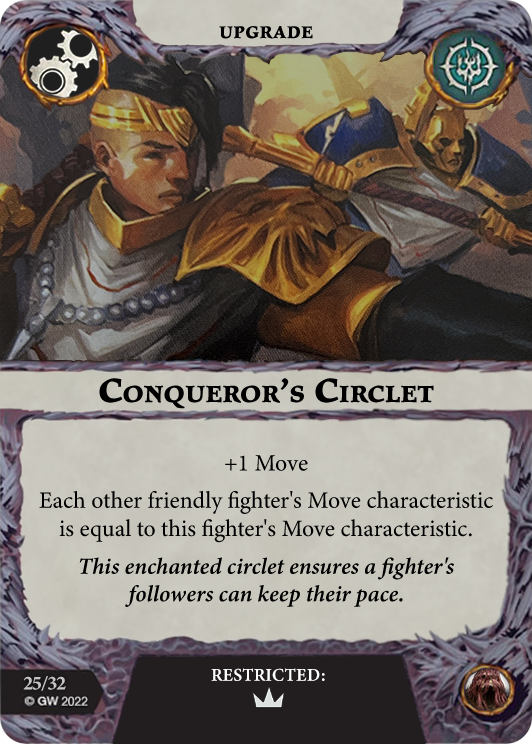 from DD). Still, this is a pretty combo-heavy card and won’t really even do all that much in the early stages of the game, I feel like it’s not enough to warrant inclusion.
from DD). Still, this is a pretty combo-heavy card and won’t really even do all that much in the early stages of the game, I feel like it’s not enough to warrant inclusion.
Power Ceiling: 1, Consistency: 1, Universality: 2
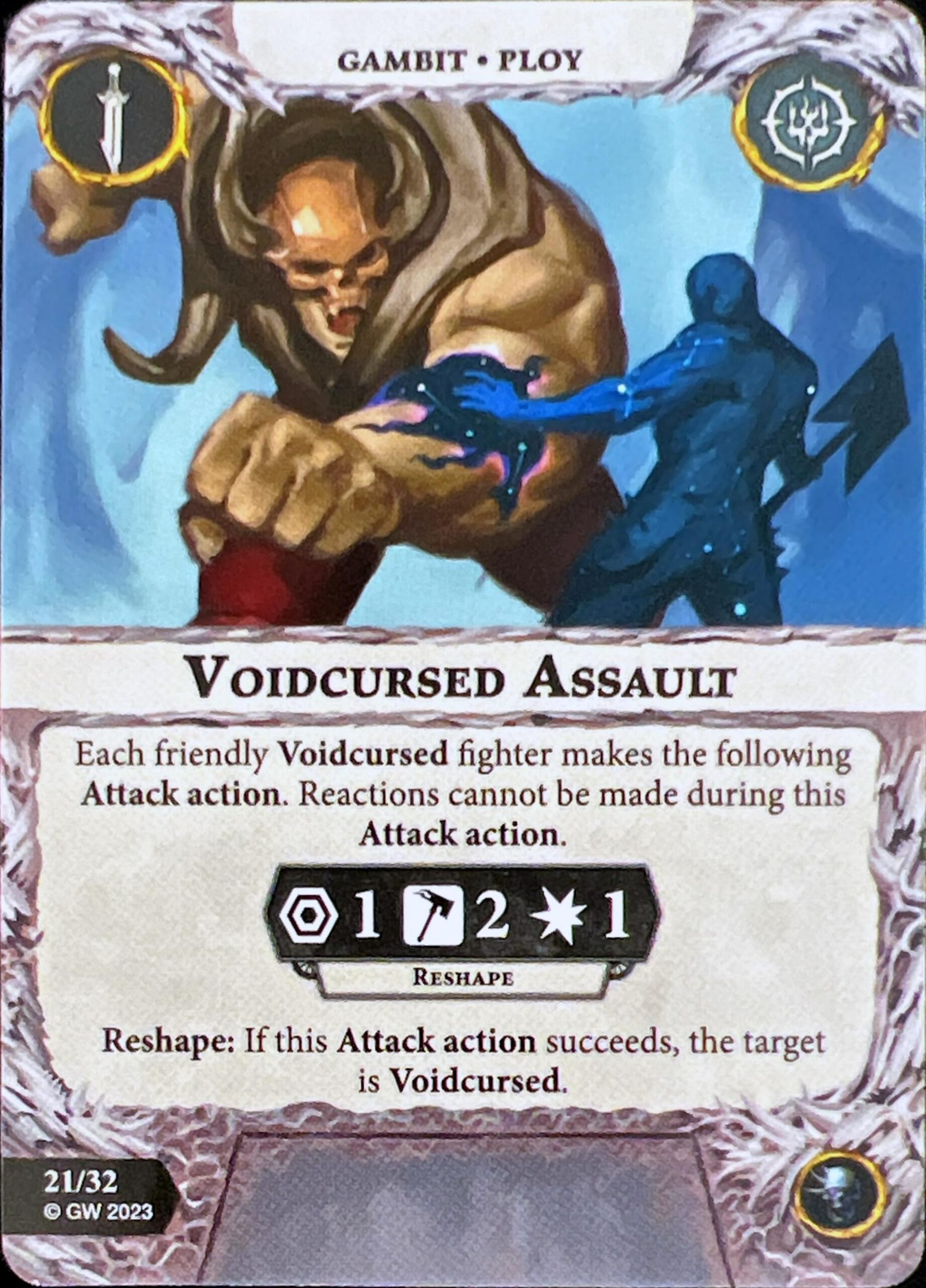
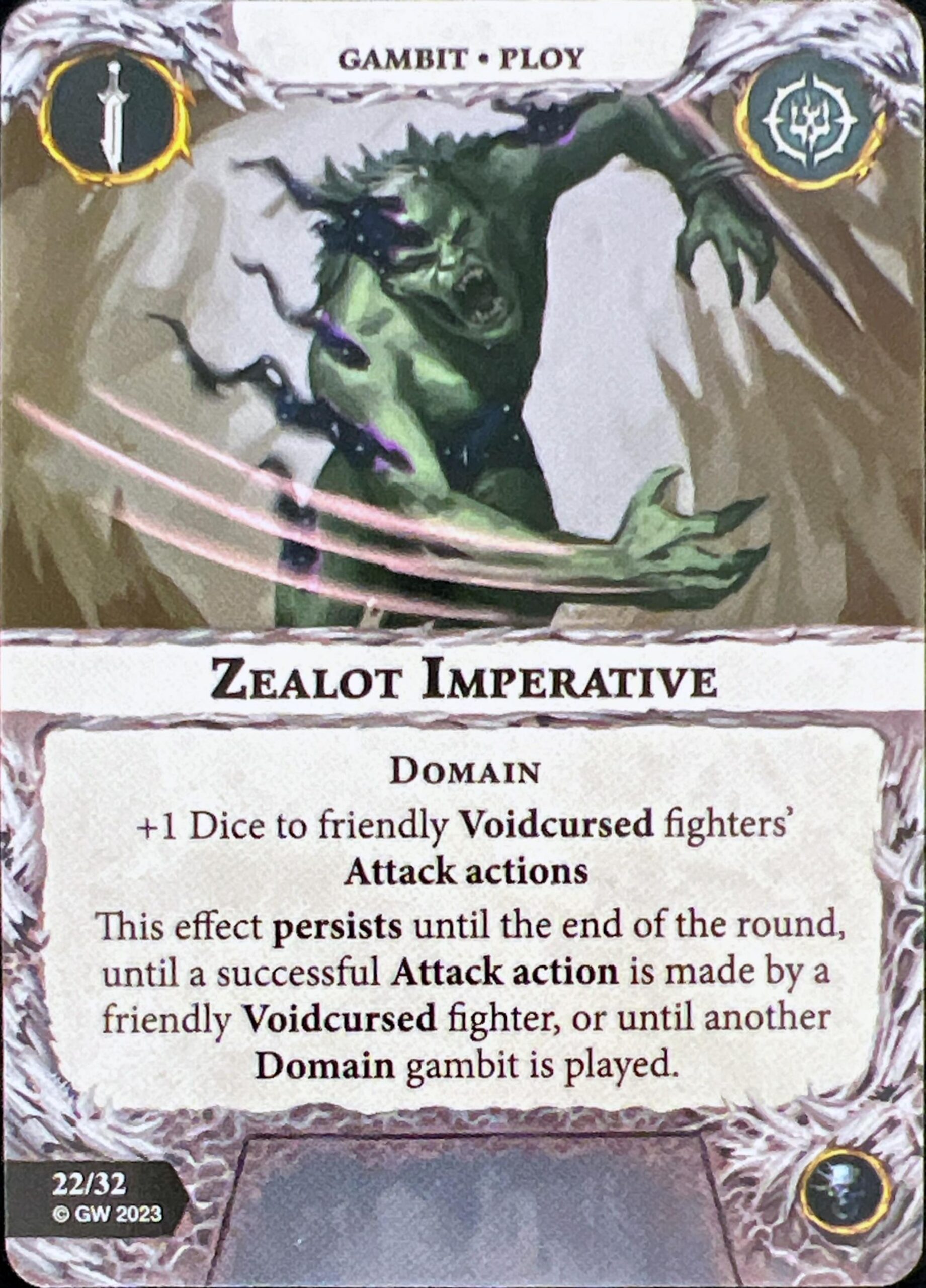
Voidcursed Assault allows you to make a 1R/2H/1D attack with each friendly voidcursed fighter that also has the potential to voidcurse the targets, if successful. Reactions also cannot be made during these attack actions. Exiled Dead again come to mind here due to their ability to swarm several targets at once (and the whole “no reactions” thing, of course). You can move during the activation, then pop this off as a mini [![]() Danse of Deintalos]
Danse of Deintalos]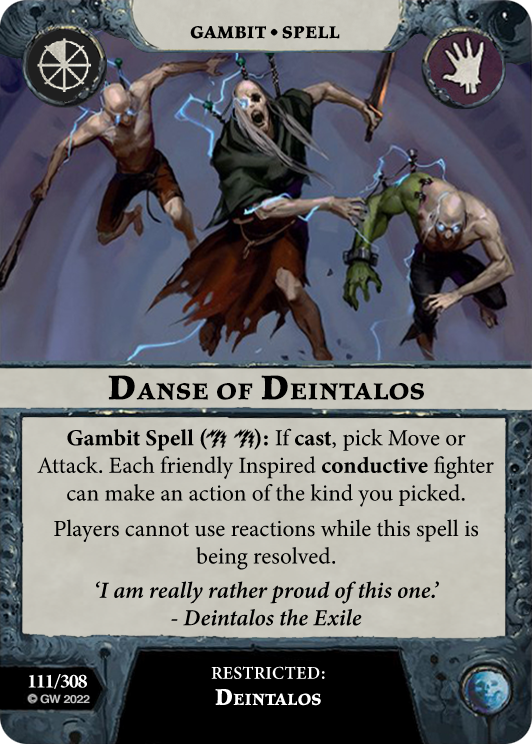 in the power step. Notably, the attack actions can be modified as well, so warbands that take extra dice or damage can profit quite nicely. Similarly, even though reactions cannot be used during the attacks, you are certainly able to react after the attacks to use things like [
in the power step. Notably, the attack actions can be modified as well, so warbands that take extra dice or damage can profit quite nicely. Similarly, even though reactions cannot be used during the attacks, you are certainly able to react after the attacks to use things like [![]() Duellist’s Speed]
Duellist’s Speed]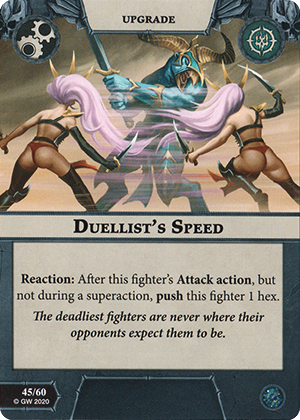 or even something more potent like [
or even something more potent like [![]() Unnerving Synchrony]
Unnerving Synchrony]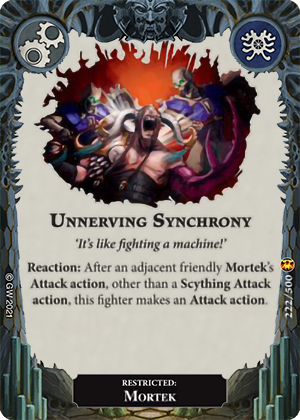 . Imagine having a voidcursed Hakor make a charge, tow along Khenta equipped with that upgrade, do attack+synchro, then jump into the power step and drop this card before reacting with Khenta again. As far as out-of-sequence attacks go, you have a lot of control over this one. The only real positional requirement is to make sure that you have your voidcursed fighters adjacent to the enemies you intend to attack, but that feels fairly trivial to me given that there is so much movement tech built into the deck and the upside of making more than 1 attack is massive. Calling my shot on this one, I think this has the potential to be the strongest gambit in the deck and it may not even be close.
. Imagine having a voidcursed Hakor make a charge, tow along Khenta equipped with that upgrade, do attack+synchro, then jump into the power step and drop this card before reacting with Khenta again. As far as out-of-sequence attacks go, you have a lot of control over this one. The only real positional requirement is to make sure that you have your voidcursed fighters adjacent to the enemies you intend to attack, but that feels fairly trivial to me given that there is so much movement tech built into the deck and the upside of making more than 1 attack is massive. Calling my shot on this one, I think this has the potential to be the strongest gambit in the deck and it may not even be close.
Power Ceiling: 3, Consistency: 2, Universality: 3
Zealot Imperative is our final gambit (another domain) that grants friendly voidcursed fighters +1 Dice until the end of the round or until a successful attack is made by a friendly voidcursed fighter (or, of course, until another domain is played). This is like [![]() Determined Effort]
Determined Effort] with both upsides and downsides. The upside, of course, is that it persists if you miss, so you can potentially reap the benefit multiple times. However, the fact that you can’t just automatically use it when and where you want it can be a bit frustrating at times, as you may really need that accuracy on a fighter who isn’t cursed yet. Still, accuracy is not so easy to come by in the more restrictive formats that you can just dismiss this card out of hand, it can still provide decent value.
with both upsides and downsides. The upside, of course, is that it persists if you miss, so you can potentially reap the benefit multiple times. However, the fact that you can’t just automatically use it when and where you want it can be a bit frustrating at times, as you may really need that accuracy on a fighter who isn’t cursed yet. Still, accuracy is not so easy to come by in the more restrictive formats that you can just dismiss this card out of hand, it can still provide decent value.
Power Ceiling: 2, Consistency: 2, Universality: 3
Our Favorites
- Mark: Voidcursed Assault
- Aman: Reshaping Snare
- Zach: Forced Movements
Upgrades
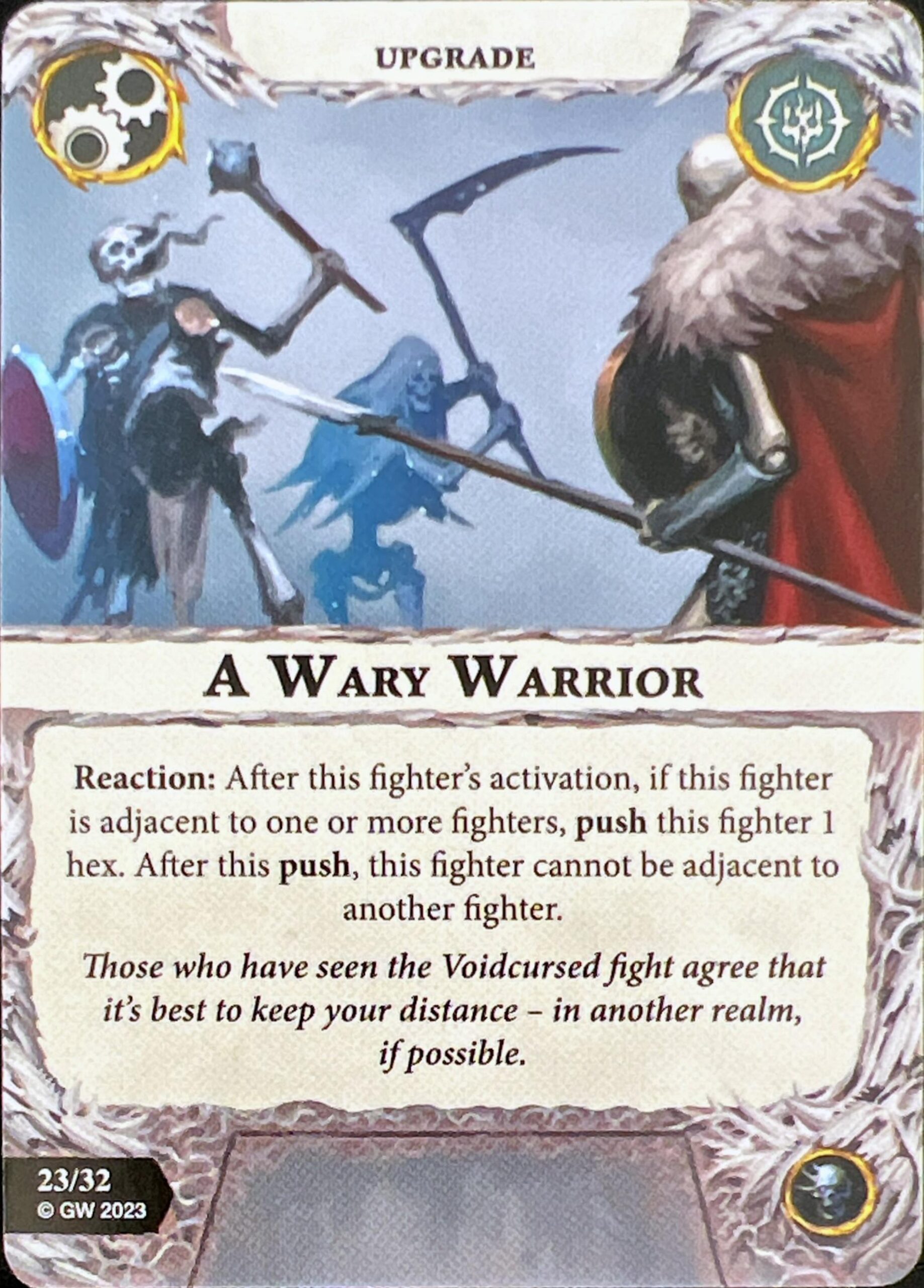

We start the upgrades with A Wary Warrior, which allows you to push 1 hex after an activation where they end adjacent to one or more fighters, as long as the push ends not adjacent to any other fighter. Quite a mouthful! I think the best use case here is probably to make a risky scything attack then push away so you don’t get absolutely bludgeoned afterwards. If you kill or drive back all of your targets, great, but at least this gives you a bit of a safety net if things go bad. You certainly don’t have so much control over this as you would something like [![]() Duellist’s Speed]
Duellist’s Speed] or the ultimate “push after activation” in [
or the ultimate “push after activation” in [![]() Soundless Step]
Soundless Step]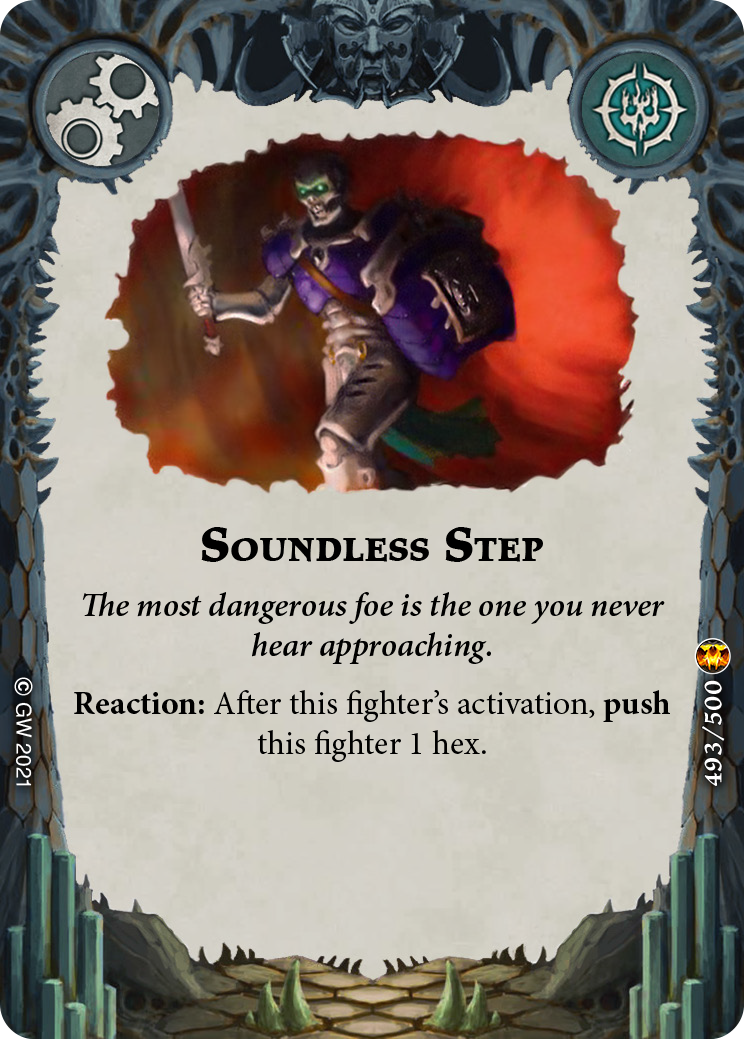 , but push economy in Rivals or Nemesis probably merits an inclusion. Hard to fit in Championship though, especially with some really good push reaction options kicking around there.
, but push economy in Rivals or Nemesis probably merits an inclusion. Hard to fit in Championship though, especially with some really good push reaction options kicking around there.
Power Ceiling: 2, Consistency: 2, Universality: 3
Energy Converter allows you to Heal(1) each time you take out an enemy fighter with the equipped fighter’s Range 1 attack. While this is restricted to voidcursed fighters, it’s actually still able to go on Large fighters, so guys like Morgok, Hrothgorn, Wielder, or even Mollog and Kainan (with their scything profiles) could make use of this. I think Sons of Velmorn quite like this as well, not just for Velmorn and Jedran, but the resurrected Grave Guard fighters also come back wounded already anyway. I think this is a pretty nicely balanced heal card, it seems not too crazy while also adding a bit of potential survivability in a meta full of ping damage. Imagine if inspired Mollog manages to land a 3-fighter scything kill and heals 3 wounds…
Power Ceiling: 3, Consistency: 2, Universality: 2


Enervating Form is another voidcursed-only upgrade, granting the equipped fighter a reaction to give a charge token to an enemy fighter after they target them with a Range 1 or 2 attack action. I think we might need a bit of a clarification here, but I believe the intended reaction step here is after the declare attack action step. Even assuming that is the case, the new charge rule does diminish the value of this card a bit, as you might just be speeding up your opponent’s potential to re-activate an even bigger charged threat. Additionally, Range 1 and 2 fighters often need to charge into range anyway to take their swing in the first place, so you’re really only neutering fighters like Drepur here that tend to swing + push a lot. Horde warbands probably are the most comfortable making these types of trades, but it’s not necessarily clear to me how much you are trading for. If you compare it to [![]() Screaming Demise]
Screaming Demise] , which allowed you to choose who got the charge token, this is a pretty significant decrease in power. Additionally, if the reaction window is actually supposed to be after the attack action is complete, you wouldn’t be able to make the reaction when your fighter is taken out of action by the attack, which would make it even worse. Don’t think it is likely to make your 10, even in Nemesis.
, which allowed you to choose who got the charge token, this is a pretty significant decrease in power. Additionally, if the reaction window is actually supposed to be after the attack action is complete, you wouldn’t be able to make the reaction when your fighter is taken out of action by the attack, which would make it even worse. Don’t think it is likely to make your 10, even in Nemesis.
Power Ceiling: 2, Consistency: 1, Universality: 2
Refashioned Priorities is a really interesting new design space for increasing movement economy. I won’t reproduce the entirety of the text, but being able to make a move action on such flexible triggers as “another fighter makes a move or attack action and is not adjacent to this fighter” really opens up some things for you. In this case, the move action the equipped fighter makes must end on a feature token, but that should be relatively doable if your positioning is good. There are so many applications to this, but I would like to highlight just a few. The first would be as a way to further increase movement economy of warbands like DKK, Reapers, and Gitz, as they can proc their movement shenanigans off this reaction to scurry around. What this also opens the door to is a rare scenario in the rules that you may never have seen in a game of Underworlds you’ve played, which is to use the “outmaneuvered” rule. Basically, the rule states that if, for whatever reason, a fighter declares a charge or attack action and, due to reasons, no longer has a valid target for the attack, the attack simply fails. Well, let’s say you want to charge at a fighter who is equipped with this card and make a Range 2+ attack action. If you don’t charge into adjacency with them, they can simply scurry away out of range onto a feature token. If you don’t have any other valid targets in range, your charge simply fails, you still get the charge token, and you’ve basically wasted an activation. To get even more wild, let’s say this equipped fighter is one of Zarbag’s Gitz and they are not the target of your charge, but are adjacent to the target (and the target does not have Move/Charge tokens). You charge at the target, but are not adjacent to the equipped fighter. The equipped fighter moves, allowing you to proc the Scurry reaction and move the target (as well as potentially other adjacent fighters) out of range as well. Similarly, you can use this during a Danse Dynamic attack series to get out of the zombie horde while some other poor soul in your warband is getting ripped to bits. There are also applications here to use this as a pseudo-[![]() Blindside]
Blindside] to get defensive or offensive supports, with the right board states, just so much flexibility to a card like this. HO should love it too for its base usage of scrambling fighters onto feature tokens, and the control you have for using it either during a friendly or enemy activation is superb. Apologies for kind of gushing about this card, but I love the flexibility and I’m glad they recognized it would be too strong to let you do it over and over again (limiting it to once per round).
to get defensive or offensive supports, with the right board states, just so much flexibility to a card like this. HO should love it too for its base usage of scrambling fighters onto feature tokens, and the control you have for using it either during a friendly or enemy activation is superb. Apologies for kind of gushing about this card, but I love the flexibility and I’m glad they recognized it would be too strong to let you do it over and over again (limiting it to once per round).
Power Ceiling: 3, Consistency: 3, Universality: 3


Part of the reason I wrote so much in our previous entry is because a lot of my commentary applies to Refashioned Reactions as well. I’m not quite sure which is better, but I tend to lean toward this card since the final positioning after the move is a bit less restrictive, only needing to end adjacent to another fighter (friendly or enemy). You can use this as a pseudo-Mortek Advance/Scurry/Kunnin’ Kommand, setting up some insane mobility of a dangerous fighter like Khenta/Kainan or Mannok. As I discussed in our previous entry, you can even proc those reactions off the effect to pull off some neat support/outmaneuvering shenanigans. This one does get a bit worse later in the game since there will be less fighters to run to, but it still strikes me as being quite powerful and worthy of inclusion if you like playing these positioning games.
Power Ceiling: 3, Consistency: 3, Universality: 3
Singular Reshaping is an interesting upgrade that you actually force your opponent to give to one of their fighters, making them voidcursed. While this would obviously be pretty busted if you got to pick which fighter took the card, I’m not sure I love your opponent getting to pick. Most warbands have a fighter who might not care about the curse, or even benefit from it, and your opponent can simply hand them the upgrade. This is pretty good support for Surrendered Will and the general gameplan of making everybody voidcursed, but otherwise is probably one you’d leave at home.
Power Ceiling: 1, Consistency: 1, Universality: 2


Surging Power is another interesting upgrade design where you get to choose one of two effects. Either the equipped fighter gains Grievous on Range 1 and 2 or they become voidcursed. I like the flexibility so you can pick which you need more at the time. I imagine you’ll often want the curse early game, but be more content to take the grievous later in the match where your fighters might already have been cursed. It certainly doesn’t stand toe-to-toe with the universal +Damage upgrades in the Championship pool, but if you are scrounging for damage in Nemesis it could be decent, especially if you are a warband that tends to roll 3+ dice with great frequency.
Power Ceiling: 2, Consistency: 2, Universality: 3
Thrallmaker allows you to make the target of this fighter’s attack actions voidcursed after the deal damage step. With the reaction timing, this very kindly means that you can use it to curse somebody as you are taking them out of action to support cards like Uncounted Cost. Of course, it also works when the target survives, but note that doing so means you will no longer be able to drive them back, so you’ll need to consider whether or not you actually want to make the reaction. It’s nice that they wrote it as a reaction so you have the choice, but I’m not sure the effect is really strong enough to compete in terms of impact on game and board state, and a lot of warbands might not really be interested in leaning into the curse aspect anyway.
Power Ceiling: 1, Consistency: 2, Universality: 2


Unnatural Resilience is a voidcursed-only upgrade for -1 Damage to Range 1 and 2 attack actions that target the equipped fighter. Damage negation is always really powerful on fighters with lots of wounds, so it’s good they caught that restriction when they designed the card. Since Range 1 and 2 is where most of the spike damage in the game comes from, not extending to Range 3+ is not so much to gripe about, although it would be nice given that Ephilim turned out to be as strong as they are from range. Certainly there are plenty of 4X4 types that would love to pack in some additional damage negation, such as Wurmspat or Madmob, but you do have to factor in the need to be voidcursed to make use of it. For this reason, you’ll probably want to focus more on warbands/fighters that only ever get as high as 1-Shield Defence anyway. Torka, for example, would be a pretty good candidate for this one.
Power Ceiling: 3, Consistency: 2, Universality: 2
Unthinking Aid is the final upgrade in the deck, allowing you to teleport the equipped fighter so that it is adjacent to a friendly leader, hunter, quarry, brawler, assassin, and/or voidcursed fighter at the start of the round. I’m not a huge fan of “start of round” cards due to providing no value if drawn in the 3rd round and having no effect during the 1st. While it might be cute to poof your fighter somewhere else, especially in a longboard configuration if they are stuck way in the back, it seems like a relatively low-impact play for how reliant it is on draw sequence. As the name suggests, you could use this to try and get support on attacks, but you even need to decide whether you’re doing it before you see the results of the roll-off. Not sure there’s really a good angle for this one, just too hard to get it to work for too little upside.
Power Ceiling: 1, Consistency: 1, Universality: 1
Our Favorites
- Mark: Refashioned Reactions
- Aman: Energy Converter
- Zach: Unnatural Resilience
Conclusions
Starting from the beginning of the article, you can probably pick up that my opinions on the deck as a whole evolved as I read more and more. I’ve elected not to re-write the earlier sections for two reasons: firstly, I believe most of my initial commentary about the reliance on the internal synergy is still valid, but secondly, I wanted you guys to see that level of understanding of the purpose of the design and function of the deck increase the more I read and re-read the cards. It’s important to, even if you feel like something seems clunky or restrictive or not what you “wanted,” take the effort to look at the cards and try and see what you can make with what you’ve got. While I always try to offer my critiques on how I think things might be improved in the future, what’s printed is printed and it’s on us as the players to find some use for it. This is why I so strongly dislike when people say that a certain use of a card or a certain format is bad or incorrect because it is “unintended.” While designer intention is important for crafting these products in the first place, ultimately the creative aspect that the player brings into it is what, for me, makes the game most enjoyable. Of course, this is why I tend to prefer playing Championship, but I think that, whichever format you prefer, trying to gain this understanding of what was “intended” while also injecting your own observations of what might “break” a card helps you grow as a builder and a player.
Tangent aside, this deck itself is certainly unique. As I established in the intro, I love the theme, art, and flavor text, just perfect. Mechanically, I do think there will be something of an identity crisis here when you go to actually build a deck. While I’ve already mentioned the reliance on the internal voidcursed synergies, being able to pick out the more universal applications of cards in this deck is important. Of course, WarCom advertised this as being an aggro-focused deck, but I don’t think that assessment really does it justice. The mechanic of voidcurse, at its core, is not inherently aggro anyway. Yes, you can only move, attack, charge, but the synergy of not being driven back opens up a lot of flex/HO playstyles. Similarly, the downsides of being voidcursed and the ability to spread this curse to your opponent’s fighters can also be used as control tools. Ultimately, the deck itself looks like it will play very differently from the others we have seen to-date (especially if you fully lean into spreading the curse), which is great! I do think that the “weirdness” of the deck and the fact that it is more combo-heavy will reduce its play rate in Nemesis and Championship (especially given the plot lock there). In Nemesis, the best warbands are generally good due to having superior in-faction options, so it will be hard to sacrifice those to clear out enough space to make all the voidcursing reliable. By the same token, a Championship player is usually limited by wanting to take powerful effects such as pushes, damage, and accuracy, so they will often struggle to clear out the space as well. However, I do think you could surprise some people with these cards and there’s a fairly high skill ceiling once you’ve mapped out the interactions and decision trees. Will you be able to transfer the power here, or will you become overwhelmed by the curse like Tynis Von Artzen?
Until next time, best of luck on YOUR Path to Glory! – Final entry in the journal of Baconborne…?
P.S. Don’t worry, there will be plenty more entries!
P.P.S. Although this weird, hazy constellation is starting to form on my arms…

















